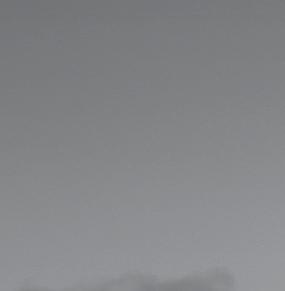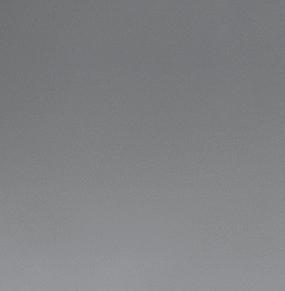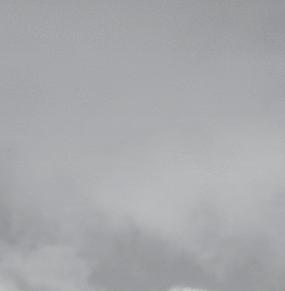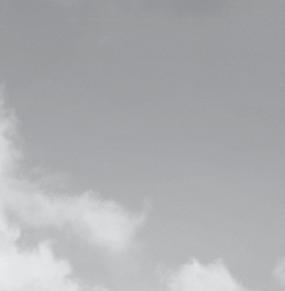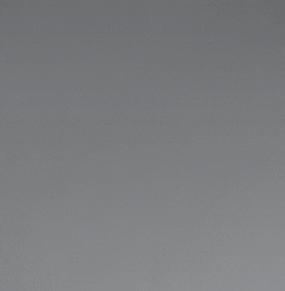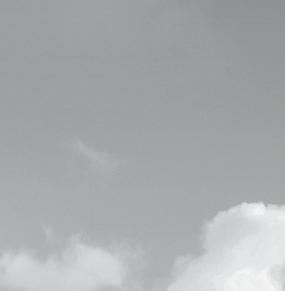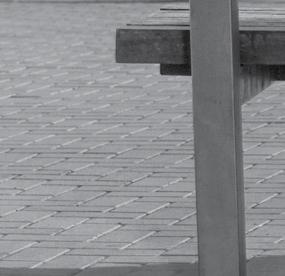




















We enable an inclusive environment for enhanced career prospects, focusing on accelerating equal opportunities for all.
At Namdeb, we are about more than mining. We are about mining for good.




- Fyodor Dostoevsky



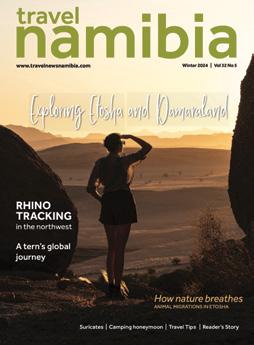
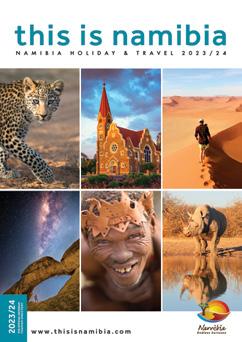

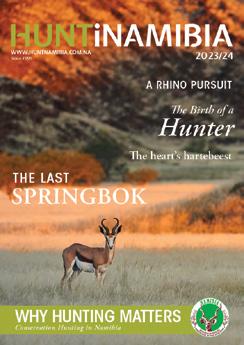


Meet the voices behind the incredible stories we share with Namibia each month. The pages of FlyNamibia are a collaboration of Namibian minds and passions and we hope you find a narrative that speaks directly to you amongst them.

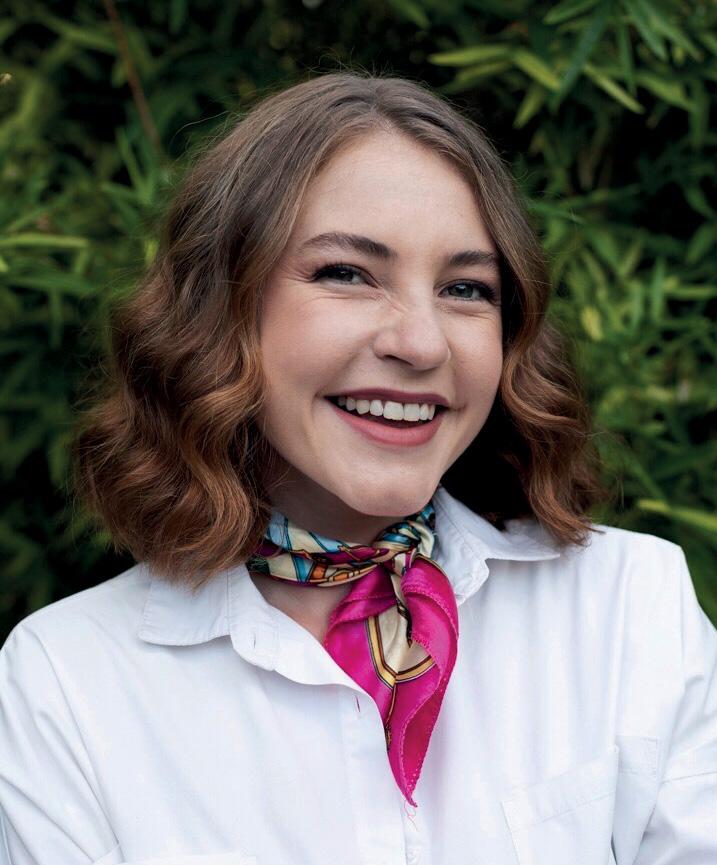
Charene Labuschagne
Art director, writer and presenter, she tells stories out of pure necessity for expression. Namibia is her favourite subject.

Barbara Kerkhof Photographer and storyteller, involved in the Africa Millimetre Telescope-project. Lives in The Netherlands, feels at home in Windhoek and loves to run mountains.

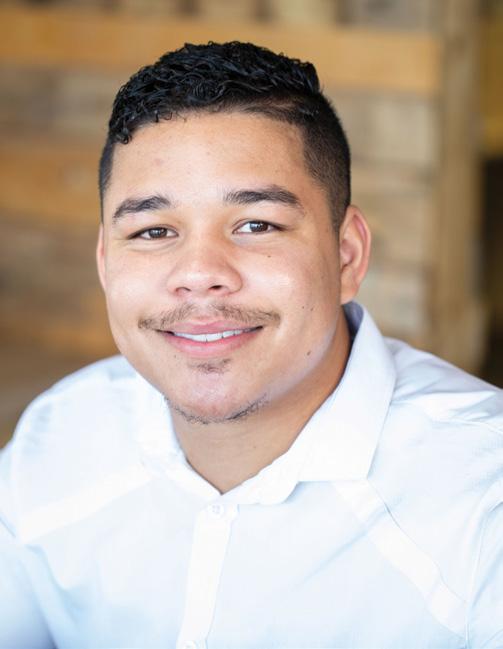
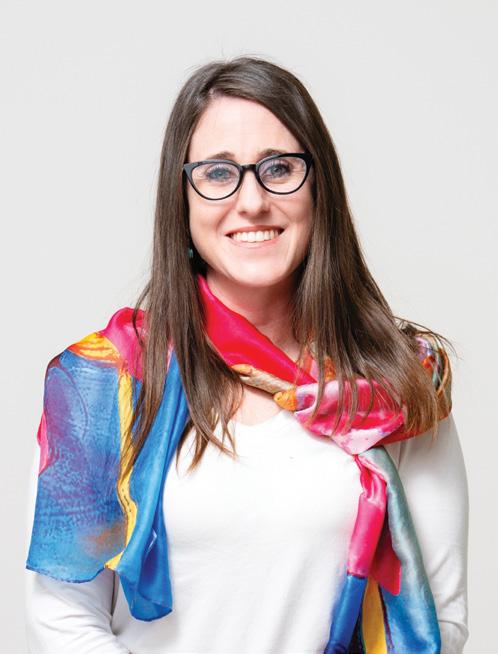
Kirsty Watermeyer
Media and communication consultant, storyteller and writer. A Multi-media producer, presenter, voice artist and curious wellbeing enthusiast.

20 Rukee Kaakunga
A Windhoek-based communications specialist, blogger and freelance fashion writer. Contact her via email: rukeekaakunga@gmail.com
David Bishop
Media commentator and critic, climbing wall owner, voracious reader, sometime writer, active lifestyle proponent, family man, and coffee lover.

Victoria Nakafingo
An aspiring astronomer, who enjoys gazing at the stars and sharing science research stories.
Zane Feris
Research Analyst at IJG Securities
Michelle McCulloch Clinic Psychologist in private practice, rehabilitation clinics and corporate settings. Educating on mental health related matters

Agnes Shivute
An environmental consultant with interest in indigenous flora, nature enthusiast, Namibia Botanical Society awardee and aspiring author
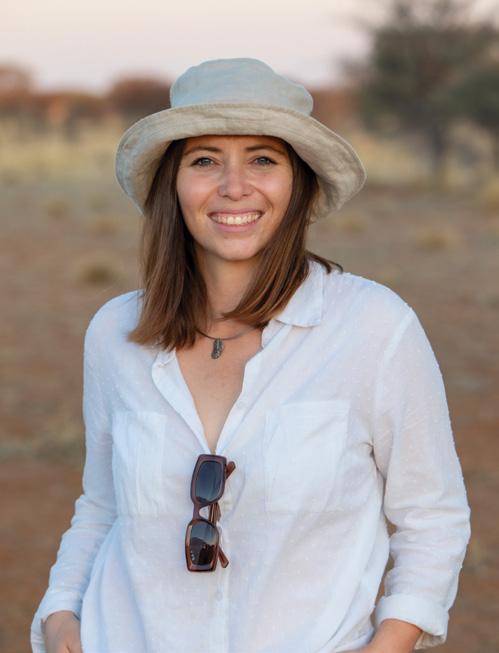
Elzanne McCulloch Writer, editor and publisher of Stories that Matter. Managing Director of Venture Media.





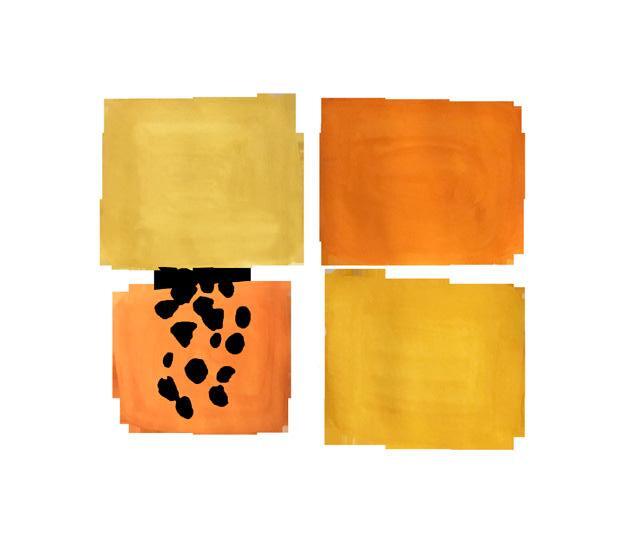

Select which tickets you would like to purchase: destinations, travel dates, morning/afternoon departure. We offer multiple fare options such as: Saver, Classic or Premium
Please enter names as they appear on passport or travel documentation
LOGIN to upload passenger details from previous booking.
More options for the perfect trip
Baggage policy, sporting equipment, over weight luggage or to add an additional bag(s)
Online check-in opens 24 hours before departure of the flight on Fly Namibia How can you make a
Cash payment at: Eros Airport, Ondangwa Airport, Oranjemund Airport
Online card transaction
Check-in opens 1h 30min before domestic flight and 2 hours before international flight.
Electronic Funds Transfer (EFT)
PayToday app Buddy SuperApp
flight information / rules
Read up on all our additional information regarding terms and conditions, and tick the selection box once completed to continue.
Fill in your payment details in our DPO paygate to make final payment.
Transaction confirmation will be sent to passenger email entered.
Windhoek Eros Airport Office
Ondangwa airport office
Rundu airport office
Katima Mulilo airport office
All major travel agents
Items NOT allowed in hand luggage:
Hosea Kutako airport office MAX 20kg Per person
Lotions and aerosols above 100ml, flammable aerosol, sharp objects, i.e. nail files, nail scissors, Leatherman, matches.

Check-in CLOSES 30 min prior to domestic flight and 50 min prior to international flight.




DEPARTURE FROM TO ARRIVAL DAYS
06:30
08:00

Eros - Windhoek
Ondangwa - Toivo Ya Toivo
16:20 Eros - Windhoek
17:50
Ondangwa - Toivo Ya Toivo
11:00 Eros - Windhoek
13:10 Katima Mulilo
09:40 Eros - Windhoek
11:20 Oranjemund
Ondangwa - Toivo Ya Toivo 07:30 Mon, Tue, Fri
Eros - Windhoek 09:00 Mon, Tue, Fri
Ondangwa - Toivo Ya Toivo 17:20 Tue, Wed, Thu, Fri, Sun
Eros - Windhoek 18:50 Tue, Wed, Thu, Fri, Sun
Katima Mulilo 12:25 Wed, Fri, Sun
Eros - Windhoek 14:40 Wed, Fri, Sun
Oranjemund 10:40 Mon, Tue, Thu
Eros - Windhoek 12:20 Mon, Tue, Thu
13:00 Eros - Windhoek Lüderitz 14:00 Mon, Tue, Thu
14:40 Lüderitz
DEPARTURE FROM TO ARRIVAL DAYS
10:15 HKIA -
10:15 HKIA - Windhoek Maun 11:15 Wed, Fri, Sun 12:15 Maun HKIA - Windhoek 13:15 Wed, Fri, Sun
in Partnership with

14:00 Cape Town Walvis Bay 16:15 Mon, Tue, Wed, Thu, Fri, Sun
16:50 Walvis Bay Cape Town 19:00 Mon, Tue, Wed, Thu, Fri, Sun
12:05 Cape Town Walvis Bay 14:20 Sat
14:55 Walvis Bay Cape Town 17:05 Sat
06:20 Cape Town HKIA - Windhoek 08:35 Mon, Tue, Wed, Thu, Fri
09:25 HKIA - Windhoek Cape Town 11:35 Mon, Tue, Wed, Thu, Fri
10:45 Cape Town HKIA - Windhoek 13:00 7 days a week
13:45 HKIA - Windhoek Cape Town 15:55 7 days a week
17:10 Cape Town

HKIA - Windhoek 19:25 Thu, Fri, Sun
07:00 HKIA - Windhoek Cape Town 09:10 Mon, Fri, Sat
Eros - Windhoek 15:40 Mon, Tue, Thu DEPARTURE
10:00 HKIA - Windhoek Keerweder 10:55 Mon, Wed, Fri, Sat
11:20 Keerweder Swakopmund 12:10 Mon, Wed, Fri, Sat
12:50 Swakopmund Twyfelfontein 13:30 Mon, Wed, Fri, Sat
14:00 Twyfelfontein Ongava 14:40 Mon, Wed, Fri, Sat
15:05 Ongava Mokuti 15:30 Mon, Wed, Fri, Sat
16:00 Mokuti
HKIA - Windhoek 17:00 Mon, Wed, Fri, Sat
10:00 HKIA - Windhoek Mokuti 11:00 Tue, Thu, Sun
11:30 Mokuti Ongava 11:55 Tue, Thu, Sun
12:20 Ongava Twyfelfontein 13:00 Tue, Thu, Sun
13:30 Twyfelfontein
14:50 Swakopmund
15:40 Tue, Thu, Sun 16:05 Keerweder HKIA - Windhoek 17:00 Tue, Thu, Sun
07:30 Eros - Windhoek Rundu 09:00 Mon, Wed, Fri
16:00 Rundu Eros - Windhoek 17:30 Mon, Wed, Fri
*HKIA - Hosea Kutako International Airport
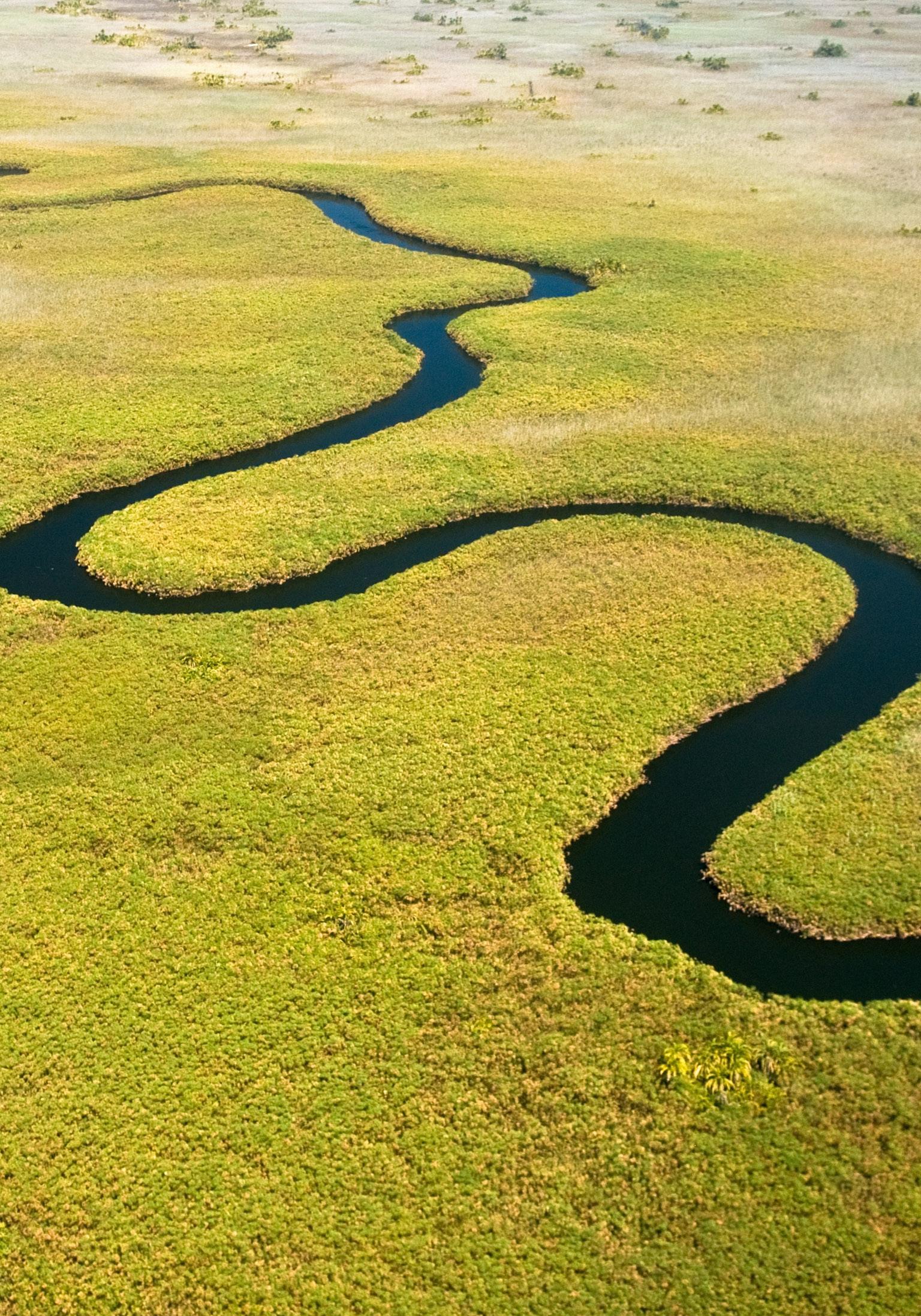


Dear Valued Passengers,
As you settle into your seats and prepare for your journey, we at FlyNamibia extend our warmest welcome. We are delighted to have you aboard and are committed to making your flight a comfortable and enjoyable experience.
Tribute to our fellow Aviators
It is with profound sadness that we acknowledge the recent tragic accident involving a non-commercial flight near Eros Airport in Windhoek on 3 May 2024. This devastating incident resulted in the loss of three cherished members of our sister company Westair Aviation’s team: Rozanne De Beer-Olivier, Ruan van Schalkwyk, and Andre-Armand Lubbe. Their untimely passing has left a deep void in all our hearts.
Rozanne, Ruan, and Andre-Armand were not only colleagues but also dear friends. We extend our deepest sympathies to their families and loved ones, and we are immensely grateful for the public's outpouring of support and condolences during this challenging time.
Opening of the FlyNamibia Lüderitz Office
In May we welcomed the opening of our new FlyNamibia office at the historic Lüderitz Waterfront Old Power Station Building. This office will serve as a convenient hub for local travellers, offering comprehensive travel services in a beautiful and historic setting. In partnership with TotalEnergies, we have also increased the number of seats available on our weekday flights between Eros Windhoek and Lüderitz, along with an adapted schedule.
Launch of New Route to Maun
Looking ahead, we are excited about the upcoming launch of our new route from Windhoek to Maun on 3 July. This new connection will open up more opportunities for you to explore the breathtaking landscapes and wildlife of Botswana. Maun, known as the gateway to the Okavango Delta, offers unparalleled natural beauty and wildlife experiences. We are delighted to make this incredible destination more accessible to our passengers.
In June, we will be participating at the much-anticipated AHIF (Africa Hospitality and Investment Forum) and AviaDev events set to be hosted in Windhoek. These events are expected to create new opportunities for Namibian stakeholders and strengthen the nation’s position as a key player in both the hospitality and aviation industries.
At FlyNamibia, our mission is to connect you with the places you love and the people you care about. We are continually striving to enhance your travel experience with us, whether through expanding our routes, improving our services, or opening new offices to better serve you. Your comfort, safety, and satisfaction are our top priorities.
Thank you for choosing FlyNamibia. We wish you a pleasant flight and look forward to serving you again soon.
Warm regards,
The FlyNamibia TeamUnique local lifestyle brands we're loving, and why you should too
We love their commitment to creating products that last. The new woven leather and solid wood bench is a collaboration between L E D and Namibhout. Not an inch of effort was spared in the making of this bespoke furniture piece! The bench is crafted from solid white oak that can be stained to suit any interior space and is woven with double layer, full grain leather strips, also available in various colours. Perfectly suited to command an entryway or grace the foot end of your bed, the L E D x Namibhout bench is sure to be an eye catcher in any room. Because L E D prides themselves in creating for longevity and timelessness, the bench comes with a 3 year manufacturer’s warranty. They are available in sizes 1m, 1.5m and 1.8m.
www.leonengelbrecht.com
@leonengelbrechtdesign
+264 81 251 2169
30 Lazarett Street, Southern Industrial, Windhoek

We love this chic and stylish sojourn in Swakop. Located on the town’s prestigious platinum mile, Swakopmund Sands occupies sea facing real estate just a hop, skip and jump from restaurants and shops. Oozing old world charm with modern amenities, the hotel offers standard rooms for both 2 and 3 persons as well as luxury suites and cottage rooms, all decorated with classy and cosy finishes. Savour a stellar on-site breakfast before exploring the charming coastal town, and return to blue and beige hued comfort at Swakop Sands. Or bask in the sea breeze on your suite deck when the sun beckons, with a red wine or whiskey from the fully fledged hotel bar. In a town with accommodation options, Swakop Sands’ intimate and refined atmosphere is a no-brainer.
+264 64 462 628 (Reception) | +264 64 405 045 (Reservations) info@driftwood-namibia.com


We love their ethos of self love. Meraki Wellness Centre hosted their first Ladies Pamper Party on the 4th of May, combining therapeutic spa treatments with the wise words of psychologist Parista Heita. Dressed to impress, attendees were treated to bubbly, mini massage treatments and an informative talk on women’s mental and physical health at the Olof Palme branch. Meraki Wellness Centre is not simply a spa, but a holistic wellness destination. Through events like the Ladies Pamper Party, which will see another edition very soon, the spa seeks to facilitate self care in all aspects of women’s lives, from mind to body and soul. Keep a lookout on their pages for updates on the next Ladies Pamper Party event.
+264 81 247 8077
Meraki Wellness Spa: 150 Olof Palme Street, Eros, Windhoek
Meraki Wellness Centre: Unit 16, The Village, Liliencron Street, Windhoek


We love their exceptional offerings, not only with regard to accommodation but also the event and conference facilities. With a focus on providing unparalleled experiences, Droombos redefines corporate conferencing by providing state-of-the-art facilities, including indoor and outdoor spaces, breakaway rooms, and top-notch audiovisual equipment. Their approach emphasises opportunities for connection and growth, complemented by unique team-building activities and customised catering options. Moreover, their stunning on-site accommodation ensures that events are more than just gatherings – they are unforgettable experiences, perfectly blending business with leisure.
www.droombos.com.na reservations@droombos.com.na or events@droombos.com.na +264 81 872 2613 | +264 83 288 8352 | +264 61 250 238


Are you a Nam or SA based lifestyle brand? List your label with us for only N$1,000 per month for 6 months | fly@venture.com.na




It’s a cloudy and crisp morning, still dark. The proverbial rooster has yet to crow. On an open game viewer we go slow and steady down Grootberg mountain. Just as the first light of dawn appears, a soft rain breaks. That is not ideal for rhino tracking but we remain optimistic, and soon enough the rising sun dries up the fine droplets, marking the start of a rugged journey into the habitat of Namibia’s endangered black rhino.
And rugged it is. Damaraland, and the Grootberg area in particular, is one bumpy ride. Part of the pleasures of this landscape’s surreal rock formations go hand in hand with incredibly rocky terrain. It’s an adventure, and we take every hiccup and to-and- fro sway as such!
Venturing deeper and deeper into the valley landscape with its undulating hills and rivers, we first disembark at a spring. The tracking has begun long since, as the rhino trackers in our midst peer out of the game viewer, zoning in on every detail that the ground might reveal. This spring shows a few tracks of a rhino mother and calf. Our guides indicate that they might be from more than a day ago and not fresh enough to continue the expedition on foot, just yet.
Over another hill and around another bend, through the boulders and large mopane trees, we arrive at another spring. This time, the tracks are fresh. There should be at least three rhinos in the vicinity, and now the adrenaline kicks in. A large mammal with an incredible sense of smell and hearing, but poor eyesight, stands in this unfenced wilderness and we are in its domain, at its mercy. Onwards, the cruiser pulls up out of the valley. From this vantage point, within seconds of us stopping there, the trackers identify a large male rhino, snug in the mopane bushveld, on top of the next hill.
Our guide grabs a fistful of soil and opens his hand. The dust drops at an angle, indicating the wind direction. We are upwind from the rhino. One whiff of our human scent will send him scurrying into the bush, ending the sighting. With the trackers continuing on foot in search of the mother and calf who left their tracks at the first spring, the rest of our group quickly gets onto the vehicles, hoping the male had not yet noticed our presence.
A fast manoeuvre brings us to the next hill. Engines are instantly switched off. The guides speak in a whisper and, instinctively, so do we, disembarking and following in single file. Dry grass and soil soften every step, nothing else besides the breeze makes the slightest sound.
Our group takes position at the edge of this high ground, binoculars in hand and with hearts racing, while merely 40 metres away and safely upwind, the silent giant stands sentinel. There is much to be said for witnessing wildlife in their natural habitat. It is every bit as frightening as it is aweinspiring, a moment to reflect on the plight of these intensely poached animals, and how they thrive in a forlorn landscape such as Damaraland, and the men patrolling this environment on foot, bent on protecting them. Without a fence or manmade waterhole in sight the reward feels greater, considering the lengthy time it took to track this rhino. The sighting was never guaranteed, as nature has a way of humbling us. We spend a good 20 minutes, reminded of where we are by the deafening silence, the burnt apricot-coloured landscape that increases in colour saturation with every passing minute, as the sun rises into the sky.
A successful rhino-tracking expedition is marked by a handful of variables. The very first order is whether or not the animal knows of your presence. Staying silent, approaching from downwind and maintaining a safe distance are the hallmarks of this. If a calf is present at the sighting, your guide will be extra alert, reading the demeanour of its mother. Should she grow weary and show signs of discomfort like looking around consistently, and guarding her calf with bombastic moves, the sighting should be ended. Some guides might want to get their guests as close as possible to the rhino. But however great the photos might be, risking your life and subsequently that of the animal, is certainly not worth it. Keeping in mind that we intrude into a domain where these beacons of conservation roam freely, a safe distance is always better.
By no means are the goals of rhino tracking, anywhere in the world, to replicate a zoo setting. Being here, on foot in the rugged Damaraland landscape, in close proximity to a fiercely wild animal is worth far more than taking any risks might be.
Taking in the final moments with this magnificent black rhino bull, a heartfelt gratitude sinks in. It is a sobering thought that these mammals, so deeply misunderstood and endangered, can live freely, guarded by the Save the Rhino Trust trackers and conservancy rangers. This is where they truly belong, and so we tread softly back to the game viewers, feeling deeply responsible for their continued conservation and protection.
Charene LabuschagneFirst published in the Winter 2024 issue of Travel Namibia magazine. Subscribe to Travel Namibia here: www.travelnewsnamibia.zinioapps.com/shop
A shining example of the possibilities of community collaboration, Grootberg Lodge is owned by the local conservancy and managed by Journeys Namibia. The result is warm hospitality and pride in the services provided by the local Damara community, who have a vested interest in the success of this special place. The staff at Grootberg, from the front desk to the guides and waiters, strive to share their homeland with visitors through impeccable service and a personalised touch.
Perched on a fold of Grootberg mountain, a cascading valley is spread out at the doorstep of the lodge. Every room, built from natural materials and making for a cosy sojourn, features a lookout deck. Lying in bed with the curtains drawn, this rolling landscape, where the valley gives way to flat-top mountains in the hazy distance, goes on for countless kilometres beyond the foot end of your bed. Perhaps one of the few places in the country where remaining at the lodge, lounging by the pool or taking a short walk along the mountain ridge, is precisely what you ought to do. Besides a rhino tracking expedition and a sundowner scenic drive, this view is the number one attraction at Grootberg Lodge and should be savoured for as long as humanly possible.
For more visit journeysnamibia.com
If you’re studying abroad or are enrolled online with an international university, you can pay your overseas tuition fees in $, £ and €.
You can also:
Swipe at POS devices & withdraw at ATMs overseas*
Pay subscriptions such as Netflix , Apple & Samsung
Buy online in a foreign currency
Travel and transact without exchanging currencies

*Countries outside the Common Monetary Area (CMA), namely Namibia, South Africa, Lesotho and eSwatini
Ts & Cs apply
Open an FNB Global Account for only N$5,000 and star t your journey towards becoming a global citizen today. 061 299 8668

375 ml milk
15 ml gelatine
375 ml cream
80 ml castor sugar
30 ml Frangelico liqueur
BERRY COULIS
250 ml castor sugar
1 cinnamon stick
250 g fresh or frozen mixed berries
125 ml good quality red wine Extra mixed berries, for garnish

• Use your fingertips to apply a thin film of light olive oil to the inside of six 150 ml moulds.
• Place 45 ml of the milk in a small bowl and sprinkle with gelatine. Leave to dissolve for a few minutes.
• Put the remaining milk in a pan with the cream and sugar and heat gently while stirring, until almost boiling.
• Remove the pan from the heat, add the gelatine to the cream mixture and whisk until dissolved.
• Leave to cool for 5 minutes, then stir in the Frangelico.
• Pour the mixture into the prepared moulds and chill until set (about 4 hours).
• Put the sugar and 250 ml water in a pan and stir over medium heat until the sugar has completely dissolved. Do not boil.
• Add the cinnamon stick and simmer for 5 minutes.
• Add the berries and wine and boil rapidly for 5 minutes.
• Remove the cinnamon stick and strain the sauce through a sieve. Discard the seeds.
• Cool and then chill in the refrigerator until serving.
• Unmould the panna cotta and place in dessert dishes. Pour tablespoons of sauce over each panna cotta and garnish with extra mixed berries.

Discover more of Antoinette's delicious recipes in Life on a Table
To order your copy contact Bonn Nortjé at Venture Publications: bonn@venture.com.na













As the Kalahari Desert is covered with darkness and the silence so present that it is almost tangible, an alarm clock starts to beep softly. Before the birds sing their first songs of the day, an astronomy student rubs his eyes and wonders where on earth he is today. He opens his eyes, and a sudden rush of excitement comes over him: he is in the Kalahari, in a beautiful lodge (thank you, Gondwana). In the adjacent cabins, his fellow students also wake up. After a quick shower, the first signs of daybreak are here and the stars slowly fade away.
The van is waiting at the parking lot. The team silently packs the van and the trailer and gets on the way to Stampriet, a little village in the Kalahari. While driving on the endless dirt road in an old riverbed, only the ones who manage to keep their eyes open see the pristine sunrise on the horizon. Some doze off, some chat, some sip their coffee.
Arriving at the village, the school kids are wide awake and already on their way to the planetarium, which is being set up in the local hostel. They come running through the dusty streets, where the heat is already kicking in and a prisoner shouts from the police station. The church looms large, and the local bar is already open. This place looks peaceful and raw.
The children look curious but too shy to ask questions. The team continues to unload the car and blows up the dome inside of the hall while smiling at the kids who press their noses against the window to witness everything happening in there. Then, finally, the dome is ready, and the first
astronomy lesson starts outside. Questions about the moon, the sun, Earth and black holes that are lightyears away from everything we seem to understand.
It is these questions – and the answers that they get to share with thousands of children, teachers, parents and communities – that keep the team going and make them find their Ikigai: their reason to get out of bed before the world awakes, the reason to study the most difficult questions in life, the reason for long workdays, for all the travelling, for being part of the AMT planetarium team.
The sun rises and stays right above that hostel building in this remote village. Temperatures are rising, questions are being posed, answers are being explained, cookies are being consumed and litres of water are washed down thirsty throats. Only when the sun starts to set, the team takes a moment to breathe. They just packed and unpacked the whole inflatable dome again and set it up in the red desert sand for one last late-night show to thank the Gondwana staff for hosting the team at their lodges and providing lovely food.
People are never unwilling to help the team, and the team is never unwilling to go the extra mile to give back. The stoke is high when the jeeps drive up and down in the desert, while shooting stars above the planetarium make big wishes come true. But first, the team is hoping for a small wish to come true: a good night’s rest… before the alarm goes off again before sunrise.
Barbara KerkhofThe Africa Millimetre Telescope (AMT) is a project run by Radboud University (The Netherlands) and the University of Namibia for building a 15-metre-large radio telescope on or near Gamsberg Mountain. This telescope will be unique in its kind, as it is set to be the first completely newly built facility to be part of the Event Horizon Telescope (EHT) – the project that realised the historical first image of a black hole, and it will be the only telescope of its kind in the whole of Africa. An integral part of the AMT project is a social programme which includes a mobile planetarium – an inflatable dome that can host up to 30 kids at a time and in which shows about the wonders of the universe are displayed in an interactive way. FlyNamibia, together with Nedbank, Gondwana, Lithon Foundation, Minds in Action, Ineos Grenadiers, the Namibia Scientific Society, GREE, Perfect Glass and Eduvision are proud sponsors of the AMT mobile planetarium.





Mooks finds himself opposite a tower of inspiration in the form of the hugely talented and hardworking Girley Jazama. Girley is an actor, writer and producer forging paths in the Namibian film and TV industries while maintaining a position as head of client services at Ogilvy Namibia. She shares her experiences and wisdom from 15 years of constantly pushing herself to take on bigger and higher challenges.
Girley is an experienced copywriter and content producer, having lent her expertise to numerous advertising agencies in Namibia, including a stint as content director at 99fm back in 2017. Her work in advertising has earned her a collection of awards, including recognition at the AfriCannes Awards during her tenure with TBWA\Paragon from 2010 to 2014.
It is no surprise that Girley has flourished in the creative industries over her distinguished career. Throughout her childhood, she spent many hours writing stories, immersed in fictional worlds. She began acting as a young schoolgirl in a primary school production of The Lion King where she played the wise Rafiki. “That set the premise for who I am today,” she tells Mooks.
Now, she is considered a Hollywood Immersive alumna, having played in film, television and theatre productions in Namibia for more than 15 years. She co-wrote and -produced Baxu and the Giants, an award-winning short fiction film which was the first Namibian film to stream on Netflix. The White Line, which she co-produced, was a

hugely successful feature film and Namibia’s first ever submission to the Academy Awards and the Golden Globes. She most recently starred in Measures of Men, directed and written by Lars Kraume, and on the horizon awaits a highly anticipated TV series which is currently in development.
With so many projects and expectations, she says managing the demands on her time is simple: “I am very selfish about separating my work and personal life. So, when I get home at 7 o’clock I put my phone away. I think I have mastered the art of separating the two.” And yet, Girley’s family is also a steady source of motivation for working hard and pushing herself to take on the next challenge. She shares her deep grief of losing her sister last year. “Right now, my motivation is living life to the fullest in honour of her,” she says.
Girley’s advice for young creatives is to look inward. “Stop seeking external validation,” she warns, knowing that we must be willing to fight for the things that are important to us. “Nobody is going to understand your journey because they don’t know your vision. So, don’t ever be deterred.”
Proudly Sponsored by



n the realm of artistry, where creativity intertwines with passion, Nessy Hilifilwa stands as a testament to the transformative power of dedication and mentorship. His journey as a photographer was moulded by renowned Namibian photographer, Tony Figueira, a luminary in Namibia's photography sphere. With profound gratitude, Nessy acknowledges, "I am today, because of Tony Figueira. He mentored and groomed me." Under Tony's guidance for six years, Nessy not only honed his technical skills but also gained invaluable lessons on the business facets of photography, laying the foundation for his future endeavours, where he today owns his own business together with his wife.
Fuelled by an innate curiosity for technology and a passion for visual storytelling, Nessy pursued Media Studies at the College of the Arts. Reflecting on his academic journey, he shares, "I majored in graphic design, which I believe has given me an advantage with my photography."
The symbiotic relationship between mentorship and opportunity manifested when Andrew Weir, a lecturer and friend of Tony Figueira, recognised Nessy's dedication and recommended him to assist Tony. Nessy explains that “Andrew saw my passion, I was one of the top students in my class.”
This pivotal moment marked the beginning of a transformative chapter in Nessy's life under Tony's mentorship. “I learnt so much from Tony. Today I often think about how fortunate I was to be mentored by one of the best photographers in this country. It moulded me and made me into the person that I am today.”
Tony Figueira's legacy reverberates through Nessy's work. Reflecting on Tony's influence, Nessy remarks that if he could speak to him today, he would say that he’s “really grateful to him to have made me the person that I am today. I think my work speaks for itself, and if he could see it, I know he'd be proud.”




...his heart remains tethered to the rugged terrain of Namibia, where he finds solace in capturing the untamed beauty of its landscapes.


Nessy’s favourite photography demonstrates how his heart remains tethered to the rugged terrain of Namibia, where he finds solace in capturing the untamed beauty of its landscapes. He has a fervent desire to showcase the splendour of his homeland.
As Tony Figueira used to teach, "photography is painting with light," says Nessy, who seeks to illuminate the beauty inherent in every moment. Through his photography, he hopes to inspire an appreciation in his audiences, “I hope that through my photography I can show the people that the world is beautiful.”
Nessy feels fortunate as a photographer, being the one who truly focuses on each moment to discover the perfect image within it. Nessy illustrates this through a recent incident when he was chosen to document the King of Belgium's visit to Namibia. While at the coast, he keenly observed a captivating interplay of colours in the sky. "That's the essence of my photography," he explains. "I immerse myself in the surroundings, noticing every detail. At that moment, I saw a beautiful array of blue and orange hues. I mentally framed the shot and captured the image."

Nessy is today seeing the world with his art. Notable moments include being selected to cover an oil and gas conference in Dakar, Senegal or when the image he took of Sven Thieme was blown up and displayed in New York Times Square on Thieme’s winning the “Top International Executive Chairman of the Year” award.
Nessy has cultivated an impressive reputation through his photography, a journey that unfolded gradually over time. "Building recognition takes patience and consistency," he emphasises. "Persistence is key; don't lose heart, as establishing a solid reputation requires time and dedication." With fifteen years in the field, Nessy attests that persistence pays off. "Consistency leads you to a place where you thrive, enabling you to create something truly magical." Through his lens, he extends an invitation to behold the beauty that envelops us, urging us to cherish each moment with wonder and appreciation.
Find Nessy at: info@oyecreativestudio.com
Kirsty Watermeyer

Just over a year ago a man called Russell Cook, also known as The Hardest Geezer, ran through Namibia on his way to becoming the first person to run the length of Africa along the western side of the continent rather than the traditional Cape-to-Cairo routes.
I got to meet and talk to Russ, and I found him to be a very humble man who had managed to use running to turn his life around, having gone from someone who struggled with mental health issues, gambling and excessive drinking to someone determined to inspire as many people as possible to “use their time to do something worthwhile and live a fulfilled life”. I was especially impressed by the fact that he did not seem to be interested in the fame the run would bring him, but rather in the amount of good he could achieve. And he did, raising more than £1 million for Water Aid, which strives to bring clean water and sanitation to communities in Africa, and The Running Charity, which uses running to boost the mental health and long-term resilience of young people experiencing homelessness.
Imagine my surprise when I saw a social media post by Russ about what a privilege it was to get to run with UK Prime Minister Rishi Sunak, a man who just days before had said that the United Kingdom was suffering from a “sick note culture” and that the “everyday challenges and worries of life” were being “over-medicalised” in a policy speech that drew the ire of not only the centre-left opposition but mental health campaigners and medical specialists of all sorts. Clinical psychologist and lecturer Jay Watts even went as far as to say that the UK government’s “specific targeting of mental health claimants will have damaging and potentially deadly consequences”.
that they cannot be held to the same standards as the rest of us just because of their status or position.
I fully subscribe to the notion that you cannot truly judge someone’s response, decisions or actions until you have been in the same situation they find themselves in. A university lecturer once explained to us that the idea that you have set principles you will never break, for example, “I’d never kill someone”, is fallacious, because until you find yourself in a situation where you might realistically need to test your principles, you cannot be sure how you would react or respond. To use the earlier example: imagine having to decide whether or not to kill someone to save the lives of your family. I also understand that sometimes there are other factors at play in making decisions like the one Russ took to go for a run with the Prime Minister. But (and again, this is in no way a judgement of his decision nor me saying that he should subscribe to my thoughts or opinions) I would like to think that, had I been given the opportunity to go for a run with Rishi Sunak, I would have stuck to my principles and turned him down.
(this) got me thinking about how we put certain people on a pedestal and seem to grant them a level of respect they may not have earned, and which we would not necessarily give them were it not for their title or profession.
Like many, I also grew up being told that one should respect one’s elders and those in authority, and I believe in treating every person I meet with a healthy level of courtesy, but I most certainly do not believe that there are certain ranks or classes of people who should be respected and deferred to as a matter of fact. My own small (and mostly hollow) victory is that in my previous dealings with government ministers I point-blank refused to bow to the convention of addressing them as “honourable” – it was not because I did not believe they were worthy of the term, but rather that I objected to the idea that someone should be addressed in a way I had no way of knowing whether they deserved or not simply because they held a certain title.
This column is in no way meant as a criticism of Russ, nor to detract from what he has achieved. His post just got me thinking about how we put certain people on a pedestal and seem to grant them a level of respect they may not have earned, and which we would not necessarily give them were it not for their title or profession. Be it politicians, actors, musicians, or even business leaders, we are very often happy to overlook – or ignore for as long as it suits us – their slights and failures, or sometimes even claim
Perhaps people in positions of power would start conducting themselves in a way more deserving of respect if we did not just grant it to them automatically…
Until next month, enjoy your journey.
David Bishop

In recent years, cryptocurrencies or virtual assets, such as Bitcoin and Ethereum, have surged into the spotlight, captivating speculators, investors and technologists alike with their potential to revolutionise finance. Yet, amidst the hype and speculation lies a complex web of economic implications that extend far beyond the realm of traditional finance. Coupled with blockchain technology, cryptocurrencies are reshaping industries and challenging conventional economic paradigms. In this article, we delve into the economic ramifications of cryptocurrencies and their regulatory aspects as we explore the diverse applications of blockchain technology.
After the 2008 financial crisis, people’s trust in government institutions and banks declined. Many felt the need to move away from the antiquated, centralised structure of currency. Cryptocurrencies, spearheaded by Bitcoin, were created to address this distrust. Bitcoin emerged as a decentralised digital asset that operates independently of central authorities like banks or governments. Bitcoin provides transparency, immutability, resistance to censorship, and ensures a degree of anonymity that fiat money cannot match.
One of the most significant economic implications of cryptocurrencies lies in their potential to disrupt traditional financial systems. By eliminating intermediaries, such as banks and payment processors, cryptocurrencies offer cost-effective and efficient alternatives for transferring value globally. Moreover, they provide financial inclusion to the unbanked population, particularly in regions with limited access to banking services.
The adoption of cryptocurrencies presents both risks and opportunities for retail investors, businesses and governments. The volatility of cryptocurrency prices poses significant market risks to investors. There have been instances where Bitcoin and Ethereum experienced a staggering 30% drop within a 24-hour period. The users are exposed to market manipulation and regulatory uncertainty. Moreover, the abundance of fraudulent schemes and scams in the cryptocurrency space underscores the importance of investor education and due diligence.
However, on the other hand, there were days where the digital assets’ price rose by 30% in a 24-hour period. From

an investment perspective, these assets offer opportunities for diversification and portfolio hedging, particularly in environments characterised by currency devaluation or economic instability. Recently, we witnessed the approval of various Bitcoin exchange-traded funds (ETFs) in the United States, which allows institutional investors to allocate Bitcoin as part of their investment strategies.
While the anonymity offered by cryptocurrencies is attractive to users, it has raised serious concerns for governments, central banks and regulators globally. Cryptocurrency regulation varies significantly among US states. However, all businesses involved in exchanging cryptocurrencies in the US must register with the Financial Crimes Enforcement Network (FinCEN) and implement anti-money laundering measures. China has declared cryptocurrency business activities illegal, while in Australia, digital asset businesses operate legally but are subject to extensive regulatory requirements. The UK has imposed registration requirements on cryptocurrency businesses as well. These examples only scratch the surface of global cryptocurrency regulation, highlighting the diverse perspectives adopted by different countries.
In 2018, the Bank of Namibia (BoN) released a statement in which they strongly discouraged the public to invest or trade in cryptocurrencies. However, in July 2023, the Namibian government enacted a law to regulate virtual asset service providers (VASPs) operating in the country. The Act aims to regulate digital assets, such as cryptocurrencies, and VASPs in the country. This move represents progress in regulating this alternative asset class in Namibia, with the government creating legislation to serve as a framework for granting licences to VASPs. Virtual currencies are, however, not recognised as legal tender in Namibia.
In South Africa, the adoption of cryptocurrency became evident when Pick n Pay started accepting Bitcoin as a payment method at its various stores. Additionally, in April this year, the South African Financial Sector Conduct Authority (FSCA) approved several institutions to be licensed as crypto asset service providers (CASPs). The main objective of the licence is to protect investors and consumers, and to promote sustainable growth within the crypto industry. The FSCA, however, reiterated that
the granting of licences to CASPs does not mean virtual currencies should be viewed as a legal currency tender in South Africa.
Beyond the finance and regulation side of cryptocurrencies is the blockchain technology on which these are based. In simple terms, a blockchain is like a digital ledger that records all transactions of a particular cryptocurrency in a secure, transparent and decentralised manner. The transparency factor of a blockchain is notably impressive, as it allows anyone to view the entire transaction history on the blockchain.
Blockchain technology offers several advantages, including decentralisation, security and efficiency. Its decentralised nature ensures that no single entity has control over the network, enhancing security and reducing the risk of a single point of failure. Transactions on the blockchain are encrypted and tamper-evident, making it secure against fraud and unauthorised changes. Additionally, the transparent and immutable record of transactions promotes trust and accountability, while the automation of tasks through smart contracts improves efficiency across various industries.
However, blockchain technology faces several challenges, including scalability issues as the network becomes congested with increasing transaction volumes, leading to delays and higher fees. Additionally, the energy consumption associated with some blockchain networks, particularly those using proof-of-work consensus mechanisms, raises environmental concerns. Regulatory uncertainty and the lack of interoperability between different blockchain platforms also pose challenges for businesses looking to adopt the technology. Moreover, while blockchain provides transparency, it raises privacy concerns as transactions are recorded on a public ledger, potentially exposing users’ transaction details.
In conclusion, the rise of cryptocurrencies and blockchain technology has ushered in a new era of innovation and disruption in finance and beyond. While offering potential benefits such as decentralisation, security and efficiency, they also pose challenges like scalability issues and regulatory uncertainty. The regulatory landscape varies globally, with countries like Namibia and South Africa taking steps to establish frameworks for the regulation of cryptocurrencies and virtual asset service providers. As these technologies continue to evolve, addressing these challenges and harnessing their potential responsibly will be crucial for realising their full transformative potential in Namibia, South Africa and around the world.
Zane Feris Research Analyst







IJG believes in tailoring their services to a client’s personal and business needs. For more information, visit www.ijg.net

10 minutes with local tastemakers




Introducing the underground music maverick working his way to the mainstream, one album at a time. This is Kid Wasabi, born Eric Nengola, and he is carving a distinctive niche as a composer, songwriter, and music producer.
WHAT INITIALLY DREW YOU TO MUSIC PRODUCTION, AND WHAT KEEPS YOU PASSIONATE ABOUT IT TODAY?
I’ve always been a huge music head. I love listening to hip hop and alternative genres, but what drove me to make my own music was when I attended my first Beat Auction hosted at the Warehouse Theatre (now Brewer’s Market) back in 2015. Something about the energy, the vibrancy, the idea that I could do it myself grasped me. What keeps me driven and passionate about it today, is the ability to keep surprising myself within my own growth. Learning new instruments like the guitar, and incorporating those tools and skills into my productions is really what gets me going.
My journey officially took off in 2016, with my duo at the time ‘Peacemakers,’ when we released our first demo ‘Peacemakers and Sound Vapours’. We released three EPs titled ‘Flight School’, ‘Morose’ and ‘Love me on my bad days’, before the release of our first ever vinyl only debut album ‘Cosmic Womb.’ This process is what inspired me to dive further into vinyl only releases, and to take my strategy on marketing music to the next level, really focusing on the business aspect of “the music business,” which is what led to the first ever clear vinyl LP ever released in Namibia titled “Butterfly Echo.”
HOW WOULD YOU DESCRIBE YOUR UNIQUE STYLE OR APPROACH TO MUSIC PRODUCTION?
Three main elements set my work apart. One of the things that makes my process unique is that I use a music production centre (MPC) to craft my beats, mainly drawing inspiration from producers such as J Dilla, The Alchemist and Madlib to name a few. Secondly, I tend to use vinyl samples as the framework for most of my productions, it’s what helps me capture the rawness and the aesthetic that I want my sound to portray. The third element would be that I enjoy using live instrumentation to bring my beats to life. It adds that organic, human essence, that a strictly digital sound can’t emulate.
HOW DO YOU COLLABORATE WITH ARTISTS TO BRING THEIR MUSICAL VISIONS TO LIFE, AND WHAT DO YOU BELIEVE MAKES FOR A SUCCESSFUL COLLABORATION?
Usually, before I even consider working with an artist, I inform them of my process and my preferred way of releasing music. For example, we would have to work on a full body of work, preferably an album, which they would then have to release on vinyl. I then take them through the vast benefits and steps of releasing music this way. When I’m working with another artist, I like to build chemistry, to where I get to know them, where they’re coming from, their sparks and inspirations, and infuse that into the music, like the work I did with Diolini on ‘Butterfly Echo’.
LOOKING AHEAD, WHAT ARE YOUR ASPIRATIONS AND GOALS AS A MUSIC PRODUCER, BOTH PERSONALLY AND WITHIN THE CONTEXT OF THE NAMIBIAN MUSIC SCENE?
I aspire to not only be a Namibian producer, but expanding my wings globally, finding an audience that truly appreciates the work, and sees the value that I put into my work as an artist. I intend to learn about film scoring and pursue that as an extension of my work. Within the Namibian music scene, I hope to inspire our local artists to understand their value and understand the difference between what streaming platforms provide versus what you can provide for yourself as a signed or independent artist. The narrative of the struggling artist should be a thing of the past.
WHO ARE YOU WHEN YOU ARE NOT PRODUCING?
It’s really hard to separate myself from the music, as it’s so deeply tied to my daily life. It’s really what takes up most of my time. When I’m not making music, I like to kick back with a good horror film. There's something intriguing about the darker, more gory aspects of cinema that I really enjoy. I also recently started travelling, and I intend to do more of that… there’s just a unique way that it opens one’s mind to see things differently.
Charene LabuschagneSwitch to a world of convenience with
Say goodbye to high data charges and juggling multiple SIM cards whilst roaming.
Introducing SIM-less connectivity with MTC eSIM roaming.

SCAN OR Visit: https://esim.mtc.com.na to get started

Our monthly round-up of good books, albums, channels, movies and series.
The boundaries of space and humanity blur into a captivating tale of astronauts and their journey around our planet. As six men and women speed through space at over seventeen thousand miles per hour, they grapple with the profound impact of their mission on their lives and identities. Harvey skillfully weaves together snapshots of their experiences, from floating in gravity-free sleep to forming deep bonds amidst the vastness of space. Through intimate glimpses of their earthly connections and routines, readers are drawn into a contemplative exploration of humanity's place in the universe. Orbital is a profound and breathtaking meditation on space, humanity, and the interconnectedness of our world.
Goodreads score: 3.75 / 5 The Tortured Poets Department by

Released on 19 April, TTPD broke a few records within the first few hours of its release, including the first album to amass more than 300 million streams on Spotify in a single day. Taylor Swift’s eleventh studio album features a hefty 16 tracks with two collaborations: Fortnight featuring Post Florida!!! featuring Florence and the Machine. Swifties, as her fans are called, instantly began deciphering TTPD, drawing conclusions to her public dating life and relationships. But for those that could not be bothered by the insight into the artist’s life, the album is a delicious, good listen filled with relatable words and catchy melodies.
Our favourite track: Who’s Afraid of Little Old Me
First developed in the United States in the 1970s, the hip hop music genre has steadily grown in popularity in the decades since then. This docuseries, hosted by Juno Award-winning artist Shad, traces the genre's dynamic evolution from the early days, through the 1990s. It starts with a look at artists including Afrika Bambaataa and Grandmaster Flash, who laid the foundation for the genre as we know it today, and then moves on to other influential groups like Run-DMC and Public Enemy. The show also explores differences in hip-hop and underlying feud between the East Coast compared to the West Coast of America.
100%


Discover unparalleled conference facilities amidst breathtaking natural landscapes with Namibia Wildlife Resorts. At Khorixas Camp, immerse yourself in the rich history of ancient civilizations while enjoying modern conference conveniences.



In the arid southern region of Namibia, two brothers, Andre and Willem Kandjella, have transformed a modest communal stock farm into a thriving business venture.
The siblings’ remarkable success story began when they secured a loan from Agribank about four years ago, enabling them to purchase land and invest in livestock.
Their engagement in Agribank’s mentorship programme further fuelled their ambition and knowledge, setting them on a path toward agricultural entrepreneurship.
Born and raised with a deep-rooted passion for farming, the Kandjella brothers saw potential where others saw challenge. Their farm, located 60 kilometres from Keetmanshoop, serves as a beacon of innovation and perseverance in a region known for its harsh conditions.
Andre, 27, underscores the importance of viewing farming as a serious business venture. He advocates for a proactive approach, encouraging aspiring farmers to leverage opportunities provided by institutions like Agribank, which offers specialised loans and mentorship to empower and support emerging farmers.
“Farming is a business,” Andre emphasises, urging individuals to pursue their agricultural ideas with determination. The brothers aim to expand their operations and establish a competitive brand in the agribusiness sector, illustrating the viability of farming as a sustainable livelihood, especially for the youth.
With their eyes set on future expansion after completing their mentorship programme, the Kandjella brothers’ journey from a small communal farm to a burgeoning agribusiness highlights the transformative power of ambition, education and financial support in one of Namibia’s toughest landscapes.
Watch the original story here:
Ellen Shihepo


Medical Rescue Africa (MRA) is Namibia’s leading fixed wing Aeromedical Evacuation company specialising in the evacuation of critically ill and injured patients across Africa, 24 hours a day, 7 days a week.
MRA, through Westair Aviation, has a dedicated fleet of Air Ambulance aircraft on standby which have the ability to land on unimproved airstrips as well as to operate at night and in bad weather conditions. Air crews undergo regular refresher training, and all operations comply with the highest safety and quality standards.
MRA has its own 24-hour Call Centre with trained and dedicated operators utilising state of the art equipment and aviation information technology. The Call Centre liaises with local and international Medical Aid, insurance and medical assistance companies to help facilitate and coordinate medical evacuations, and medical repatriation services.
To ensure the best possible pre-hospital treatment to patients, MRA offers a 24-hour Road Ambulance at Eros Airport for transporting patients from the Airport to the treating Hospital. The MRA Ambulance is equipped to an ICU patient care level. MRA has a standard service-level agreement with all accredited ALS Ambulance Services across Namibia for effective Road Ambulance evacuation services should the requirement be to not activate the fixed wing Air Ambulance.
MRA is led by a management team with extensive experience in medical response, evacuation and support operations.
Tel: 912 within Namibia or +264 83 339 0033 Internationally |



The value of
(and how to be better at it)
Ever gone through difficult or painful events and the response you get from your loved ones includes the phrases “at least”, “it could be worse”, “look on the bright side”, or “it will get better”? Imagine you just lost your job and you get the following response: “Look on the bright side, at least you have more free time.” Or you just went through a miscarriage and someone responds with: “At least you can fall pregnant again.” Or you were just diagnosed with a medical illness and you get told: “It could be worse, it could be terminal.”
The truth is, when someone is going through something difficult, a response very seldom makes it better or fixes it. We usually do not want advice in a moment of vulnerability; we want validation, connection or even a hug with no words. We want the truth of our experience to be seen, heard and understood, and not compared with a worstcase scenario, or being told what to do to fix it.
In a moment of vulnerability, we want validation, connection or even a hug with no words.
Responding in this sympathetic way is trying to paint a silver lining around something that is painful, and although these responses hold some truth, it is usually received as dismissive, sugar-coating and feeling misunderstood.
An empathetic response creates connection whereas a sympathetic response drives disconnection. But what does it mean to show empathy? Firstly, it is the ability to take on the other person’s perspective and recognise it as their current truth (regardless of whether you see it differently). Basically, you put yourself in their shoes, full stop. Secondly, which is often the most difficult, we listen without judgement to allow understanding of their experience to be the focal point. Thirdly, we are recognising the emotions they are feeling and communicating that to them or repeating it to them. Lastly, we are expressing and feeling with the other person.
Next time someone is in a “dark hole”, try sitting with them in the dark hole and responding with “I can just imagine,” or “I know how painful this feels; it’s okay to feel it and I’m here for you.” This creates more meaning for that person in the moment.
As American social psychologist and bestselling author Brené Brown says, “Being empathic is choosing to be vulnerable with that person because in order to connect with someone’s pain you are connecting with something within yourself that knows that feeling.”
Michelle McCulloch Clinical Psychologist









Nine years ago, I attended Melisa Poulton’s very first official fashion show, an affair that at the time set her up as a Namibian designer to watch. The event had an air of excitement as celebs, socialites and notable Namibians ascended upon the Poulton family residence to witness a fashion spectacular of note. With most of us being starved for events of this nature at the time, the invite was a rare opportunity to dress up and savour the garments on display.
Since then, Melisa has developed a brand that is synonymous with being bold and extravagant. Her signature garment staple, manipulated tulle, has always made Melisa’s designs stand out.
Nine years on, I once again found myself at the Poulton residence – this time to attend Melisa’s boutique unveiling, featuring a colourful display of rental garments. The occasion marked the proverbial rebirth of the fashion designer who, after all these years, is embarking on a journey to Paris Fashion Week, and collaborating with one of Africa’s biggest fashion collectives.
Melisa’s career has not been easy, and she has seen some big losses in a business environment that is especially cruel to creatives. However, she has never given up, consistently putting out collection after collection and always pushing boundaries. Melisa has collaborated with some of the biggest names in Namibian music and arts, and she was one of the first to bring in brand ambassadors to market her clothing. To date, her first brand ambassador, Lize Ehlers, remains her biggest cheerleader and most loyal client.
An emotional Melisa recounted all her past experiences, triumphs and failures while celebrating her latest wins with guests at her exclusive boutique opening.
PARIS BOUND
First up on her calendar is the biggest showcase of Melisa’s career – Paris Fashion Week.
She says, “For the collection, I chose the theme La dolce vita, which literally means the sweetness of life or the good life, but for me it refers to the luxury of life. I decided this collection needs to be a collection which shows Namibian luxury. Inspired by the theme citrus, the collection will have handmade beaded fabrics and textiles made by the House of Poulton using glass beads from Namibia.”
“With this collection we want to showcase some of the Namibian culture with a modern feel, to truly show the luxury of Namibian fashion,” says Melisa.

Anyone who knows anything about Namibian fashion knows that it is a cut-throat business where fashion designers face many struggles in the pursuit of success. Melisa is no different. In an effort to scale her business and focus on streamlining her production process, Melisa has decided to prioritise production for her Africa Fashion International (AFI) contract. AFI is a South African-based organisation that curates, incubates, promotes and retails refined African apparel and accessories through its world-class lifestyle and marketing events.
“We want to move to a space where garments are readily available for customers to come and shop or order items online from our boutique. We want to shift away from private clients and more to exclusive retail. This decision also came with our recent AFI contract which requires us to provide garments to be sold in Johannesburg at their House of Nala Boutique in Sandton,” says Melisa.
According to Melisa, this partnership could not have come at a better time. “I am very grateful for this partnership and excited to see the outcome. I think it will have a big impact on the House of Poulton. We will be able to reach different types of global clients and get our product sold on international platforms. I believe the House of Poulton will reach greater heights and achieve global recognition through AFI.”
TO PARIS
To raise funds for the trip, Melisa has some exciting fashion events lined up over the next few months.
“We created these events so that the Namibian community can support us where they can and also experience high-end luxury fashion experiences leading up to our journey to Paris,” she says.
So, if you love fashion or simply love Namibia and want to do the patriotic thing of supporting our own designer in representing us in the city of fashion, here is a list of places to be to do just that:
• 28 June House of Poulton Pop-up
• 4 July Gallery Exhibition
• 19 and 20 July House of Poulton Pop-up
• 3 August House of Poulton Met Gala Dinner
• 14 September Sending-off Picnic Party
The collection will also feature diamond and crystal beads representing Namibian diamonds. True to her nature, Melisa is creating her own textile inspired by the traditional Ondelela material of the Aawambo, including some Nama-inspired patchwork. The collection will have a lot of pleats, using tulle and organza to give the illusion of a lemon slice – all the elements that scream House of Poulton, but with a traditional Namibian twist.
The events will be a prelude to Melisa’s Paris showcase. Expect exhibition style artwork, poetry and film. All kinds of contributions to the fundraiser are welcome, from attending the events to purchasing from the House of Poulton boutique, or donating directly. For more information, contact Melisa directly on Instagram @houseofpoulton or @melisapoulton
Rukee Kaakunga
WHAT DIFFERENCE CAN 1000 OUNCES OF GOLD MAKE? AT B2GOLD, WE BELIEVE IT HAS THE POWER TO HELP RURAL COMMUNITIES IN NAMIBIA SAVE A SPECIES
With a groundbreaking donation of 1,000 ounces of gold from our Otjikoto Mine in northcentral Namibia, we produced 1,000 limited edition Namibian Rhino Gold Bars. This initiative represents the first time that gold, a natural resource from the ground, was used to provide sustainable financing to community-driven efforts to protect an iconic global treasure, the critically endangered black rhino.
Proceeds from the sale of the gold bars are used in two vital ways: a portion is invested to provide long-term financing to community-driven efforts to protect Namibia’s black rhinos, while a conservation premium will be applied to activities in the field, ensuring that this support goes directly to the trackers, rangers, and communities who live alongside wildlife. Since inception we’ve distributed USD 850K in funds to various beneficiaries.
We’ve entered a strategic partnership with the Save the Rhino Trust (SRT) whereby they are the sole beneficiaries of the Rhino Gold Bar fund, and they in turn direct the funds to where it is needed the most. This initiative is innovation in action and a striking example of our commitment to creative conservation and philanthropy for the future of our planet.

through RGB sales Disbursed as of May 2024 Save The Rhino Trust is the sole beneficiary of the RGB fund; SRT directs funds where it is needed most. $1.7 MILLION



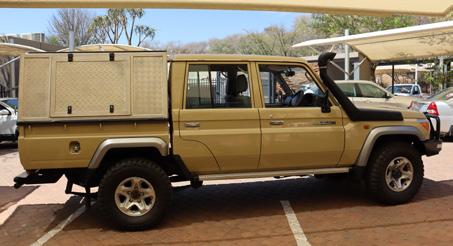



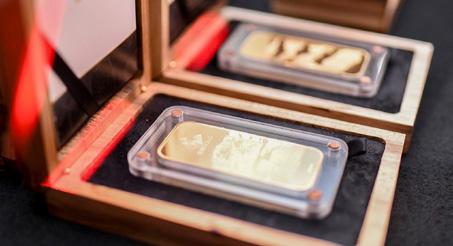

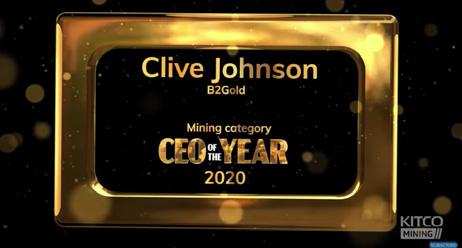












In Namibia's business landscape, success often hinges on personal connections, where business dealings thrive on the strength of interpersonal relationships. At the forefront of this dynamic exchange is the Namibia Trade Network's Business Breakfast Club — a prestigious membership-based event series designed to empower professionals with valuable networking opportunities and in-depth industry knowledge.
The Business Breakfast Club Namibia is positioning itself as the platform brimming with opportunity for entrepreneurs, executives, and aspiring professionals alike, offering a platform to stay abreast of the latest trends and developments shaping Namibia's industries. Dedicated to facilitating meaningful interactions and promoting knowledge-sharing, the Business Breakfast Club serves as a catalyst for growth and innovation within Namibia's business community.
In Namibia's business landscape, success often hinges on personal connections, where business dealings thrive on the strength of interpersonal relationships.
For professionals and business leaders seeking to expand their networks, deepen their knowledge, and make meaningful contributions to Namibia's business community, the Business Breakfast Club Namibia offers an unparalleled opportunity for growth and enrichment.
Each event features an unmissable panel discussion led by esteemed experts and thought leaders, offering invaluable insights into various sectors of the economy. The upcoming event in July 2024 promises another compelling panel discussion led by distinguished Namibian industry leaders, focusing on ‘Innovation, Technology and Communication’.
Previous panel discussions have featured esteemed figures such as Conrad Dempsey, Chief Executive Officer at FirstRand Namibia Group, shedding light on the critical significance of responsible economic development within Namibia's trade and investment sectors. Additionally, panels have included influential voices like Julia Muetudhana, Executive for Talent, Innovation, and Productivity at NIPDB, who offered insights into fostering a culture of continuous learning within businesses to navigate the challenges of an ever-changing economic environment. Notably, Julia was quoted as saying, "Learning is the humility to continue growing," encapsulating the essence of embracing ongoing growth and development.
To learn more and become a part of this vibrant community, visit www.bbcnam.com and embark on a journey of discovery, connection, and success with the Business Breakfast Club Namibia.
The Business Breakfast Club was launched under the Namibia Trade Network publication as a value addition to its Network of businesses, business professionals and government. The Namibia Trade Network’s purpose is to assist government, businesses, and business professionals in promoting investment, trade and development both locally and internationally by sharing stories and the successes of home-grown entities and connecting individuals and businesses to help collectively forge a future for Namibian trade and industry. It is the official publication used to showcase Namibia to the rest of the world.
Kirsty Watermeyer




Recent oil discoveries off the coast of Namibia (in the Orange Basin) have led to huge excitement in the energy industry, not only within the country but also across the globe, generating a wave of investors. The projected scale and quality of these oil reserves has the potential to double the size of the country’s economy by 2040 and improve the energy landscape, but it also raises questions about the geological processes behind the discovery, the challenges of exploration, and the potential impacts on the environment and society.
The Orange Basin forms part of the southwest African continental margin along the southern South Atlantic coast of Namibia and South Africa. The basin formed millions of years ago, in the Late Jurassic to Early Cretaceous periods, when the geological conditions in Namibia were ideal for the formation of oil reservoirs. The deposition of organic-rich sediments in ancient seas, combined with tectonic activity and the burial of organic material, created the ideal conditions for the formation of hydrocarbons. The geology of Namibia, characterised by its sedimentary basins and structural complexity, played a crucial role in the accumulation of oil reserves. The presence of organic-rich source rocks, highporosity and permeable reservoir rocks, as well as cap rocks provided the essential elements which are all critical components of any oil-bearing system.
The Namibian coast has been the subject of exploration efforts since the 1970s. This was a challenging and uncertain time. To find petroleum formations beneath the surface of the earth, exploration companies have employed a range of cutting-edge technology, such as seismic surveys, magnetic surveys and exploratory drilling. It was during this time that Chevron made a major discovery in Namibia’s exploration history when it discovered the Kudu gas resource in shallow waters off the country’s southern coast. Despite initial challenges and limited interest from foreign oil companies to do further exploration, success stories from other regions gave lead to a renewed interest in Namibia’s offshore potential. Consequently, the resumption of exploration activity and advancements in technology and capacity resulted in the latest discoveries (Venus-1 and Graff-1) made by Shell and TotalEnergies.
The fact that many of Namibia’s oil reserves are located in deepwater presents geologists and exploration firms with challenges such as water currents, low temperatures and temperature gradients. Success in offshore drilling operations is never assured and demands advanced technology and large financial outlays. The region’s complicated geology, which includes salt domes, folds and fractures, further complicates the exploration process. Despite these challenges, recent
advances in high-performance equipment and a deeper understanding of the region’s geology have led to significant discoveries, fuelling optimism about Namibia’s potential as a major player in the global oil market.
The discovery of oil reserves in Namibia has the potential to bring about significant economic, social and environmental changes. It is predicted that the basin holds 11 billion barrels of light oil and 2.2 trillion cubic feet of natural gas reserves, and that the oil production could surpass 500,000 barrels per day and continue to expand if the upcoming appraisal and well flow tests fulfil expectations. Additionally, the region is incredibly underexplored; therefore, we should anticipate more successful exploration and resource enhancements in future.
On the one hand, the development of the oil industry could boost Namibia’s economy, create jobs and generate revenue for infrastructure development and social programmes. However, it also raises concerns about the environmental impact of oil extraction, the risk of oil spills and pollution, as well as the potential for social disruption in affected communities. Furthermore, the reliance on fossil fuels for energy production raises broader questions about sustainability and climate change. As the world grapples with the need to transition to renewable energy sources, Namibia faces important decisions about the role of oil in its future development trajectory.
With future development in mind, there is still a great deal of ambiguity regarding design ideas, scheduling, phases, output levels and handling or monetisation of gas. Although the discovery of oil deposits has enormous potential for the nation’s economic growth, there are also a lot of hazards and difficulties involved. Thorough planning, strong regulatory frameworks and a dedication to environmental stewardship will be necessary to guarantee the oil industry’s sustainable growth. Namibia also needs to think about the long-term effects of its reliance on fossil fuels, look at ways to diversify its energy sources, and make investments in renewable energy. Namibia can pave the way for a more sustainable and prosperous future by welcoming innovation, encouraging transparency and interacting with stakeholders.
The discovery of oil reserves in Namibia marks a significant milestone in the country’s history, opening up new opportunities for economic growth and development. However, it also brings with it a host of challenges and responsibilities. By harnessing the power of geology, embracing sustainable practices and fostering collaboration, Namibia can navigate the complexities of the oil industry and build a more resilient and prosperous future for generations to come.
Victoria Nakafingo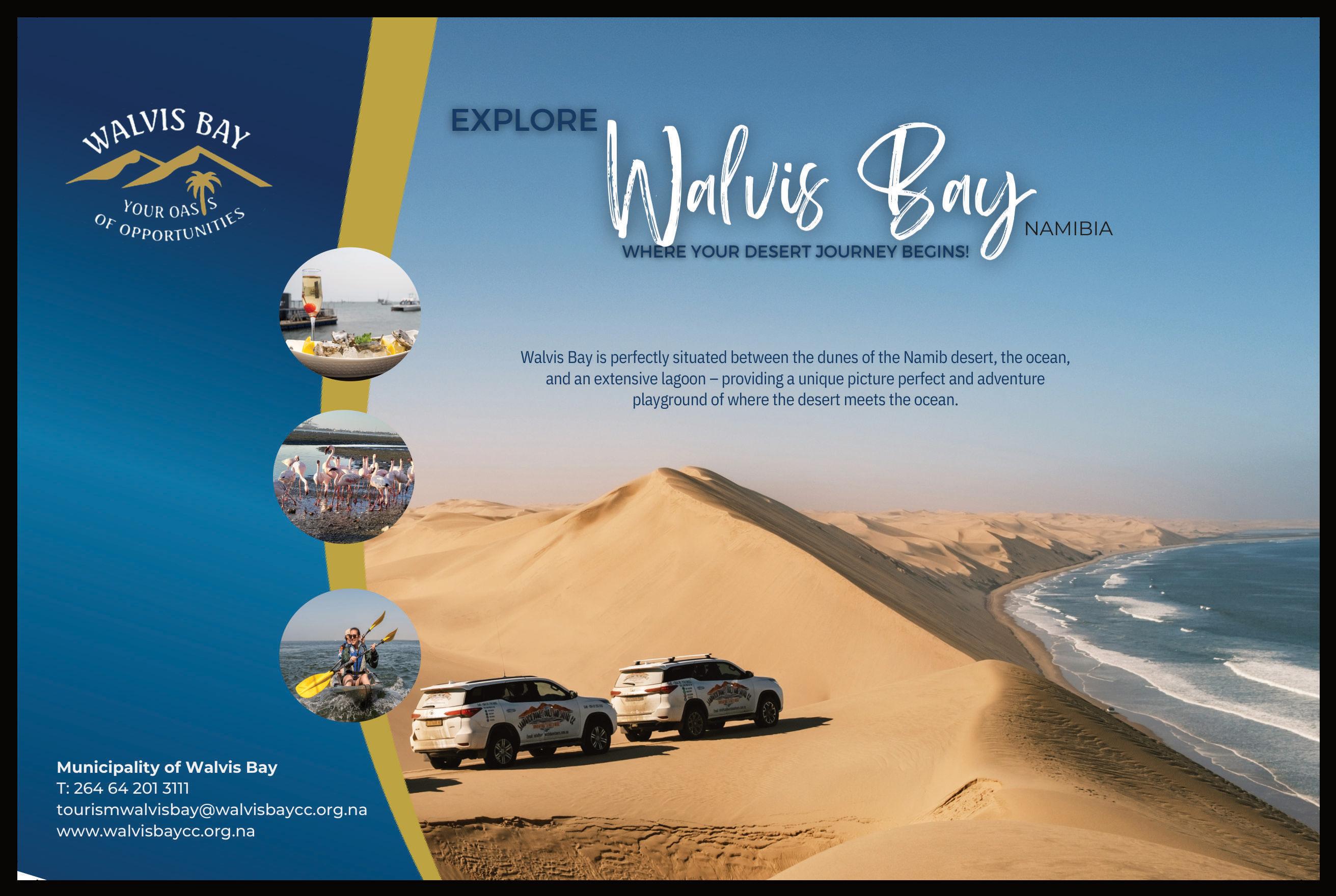

This year we're focussing on telling and sharing STORIES THAT MATTER across our various magazines and digital platforms. Join the journey and share your stories with audiences that understand and value why certain things matter.
Why ethical business, conservation, tourism, people and communities matter. How these elements interrelate and how we can bring about change, contribute to the world and support each other. Whether for an entire nation, an industry, a community, or even just an individual.
Visit www.travelnewsnamibia.com to subscribe to our digital publication on Zinio or to order physical copies of the magazine.




www.venture.com.na or email us at info@venture.com.na for a curated proposal.



All-day breakfasts are severely underrated. How many times have you paged through the menu of a quaint cafe or bistro, salivating at the variety of breakfasts, only, it's 11am, and by some simple universal law, you may not eat eggs anymore? Enter Krisjans, an old favourite among the coffee shop connoisseurs in Windhoek, serving all-day breakfasts among a laundry list of other delights.
Nestled in the centrally located Tenbergen Village complex, Krisjans boasts ample cosy, indoor seating as well as outdoor tables tucked between the charming building and on a shaded deck lined with herb and spekboom planters. Oozing European bistro vibes, the chequered floor and rustic tables, paired with a nostalgic blue hue and vintage Vespa, this daytime restaurant undoubtedly passes the aesthetics test.
Under new ownership, the menu has seen a renaissance from basic bistro items, to an impressive selection ranging from wholesome pastas and hearty salad bowls to nachos and even seared sirloin. Furthermore, their drinks selection and fully stocked bar signal a mimosa-fueled morning or afternoon cocktail, while refreshing fruit crushers are one of the best sellers – particularly the lip-smacking and tart lemonade and mint, or fresh and fruity berry frost.
Fries are a great measure of what is to be expected from a restaurant, and Krisjans tops the list of crispiest, wellseasoned shoestring fries in the city. Accompanying a grilled

chicken burger topped with brie, bacon and caramelised onions, it’s truly irresistible. The other burgers on their menu also tease with delicious possibilities, like the Korean BBQ smash burger consisting of two beef patties, chilli mayo and homemade slaw.
If you are not one to get too excited about salads, this bistro will surely surprise you. Their salad bowls feature more of the good stuff, like in the butternut and beetroot quinoa bowl, and less of the green stuff. Drizzled with a ginger soy dressing and topped with roasted pumpkin seeds, this quinoa bowl light lunch is one to return for, time and again. Alternatively, the chicken fajita burrito bowl, with guacamole, salsa, veggies and nacho chips defies the definition of a salad, but we’re not mad about that!
Lending itself to business lunches, baby showers or kitchen teas, both inside and outdoors feels breezy and calm, considering Krisjan’s central location. There truly is something on the menu for every taste, and their confections including cakes and Belgian chocolate truffles, round off the menu selection.
Be it a Saturday brunch with friends, a weekday business lunch, or anything in between, Krisjans can easily take their place as your new favourite. And if you find that you have forgotten about this little gem of a bistro, here’s your invitation to return and let their friendly staff and frankly lekker menu convert you back to a regular!
Charene Labuschagne




The Emergence of Cake in Contemporary Art





In the realm of contemporary art making and cake baking, time, focus, effort and skill are the essential ingredients. Yet, an intriguing trend is emerging – the contemporary art world is being overtaken by cake.
For some artists, cake serves as a symbolic medium, while for others, it has become the canvas upon which they express their artistic vision. Whatever the case, a widespread enthusiasm for cakes is sweeping through the art world on an international scale. Entire art exhibitions are now dedicated to cakes and the artists who adorn them, creating a fusion where aesthetics seamlessly merge with flavour.
THE ARTISTIC FUSION OF BAKING AND ARTISTRY
It is difficult to resist the allure of sweet, sugary deliciousness that defines a cake. But can an already delicious cake be made any more appealing to the senses?
Enter Chef Tash of Art’tisserie, an artist first and a pastry chef second. For Tash, creativity is not just a passion – it is a way of life. “I have always been creative,” she explains. “When I was younger, my dream was to become an artist when I grew up. I started exploring art at the tender age of four, after my pre-primary schoolteacher recognised my innate talent and recommended art classes. Art is ingrained in my identity – it’s what I believe in and what I stand for. You’ll always find me immersed in some form of creative expression.”
PURSUING AN ARTISTIC CAREER IN PASTRY
As she delved into exploring various artistic careers, none quite resonated with her until she had a revelation: why not combine her hobby and her passion? Her hobby being baking, her passion being art.
Initially setting out to pursue a career as a chef, Tash soon found herself drawn to the pastry side of her studies. It was then that she made the pivotal decision to enrol at the FBI Chef School and Patisserie Academy in South Africa. Reflecting on her entrance interview with founder Nicolas van der Walt, Tash chuckles as she recounts the memorable moment. Despite the prerequisite of having a diploma in pastry to be accepted into the advanced pastry course, Van der Walt was so moved by Tash’s unwavering passion and dedication that he made an exception. “I was so passionate about what I was doing,” Tash reminisces, “that he was like, ‘I’ll take you, I’ll just take you!’ It was a moment I’ll never forget.”
Under the mentorship of Van der Walt, an internationally acclaimed pastry chef who earned a gold medal for his craft at the world championships, Tash embarked on a yearlong journey of intensive study. Such was Tash’s exceptional talent and passion that Van der Walt went a step further, employing her as his wedding cake artist – a testament to her remarkable skills and dedication.
Following her training, Tash returned to Namibia to assume the role of executive pastry chef at the prestigious Safari Court Hotel and Conference Centre. Subsequently, she ventured to the Cape Winelands, where she served as pastry sous chef in the esteemed kitchen of the renowned Delaire Graff Restaurant. Alongside her culinary accomplishments, Tash’s artistic creations have graced the pages of numerous publications in South Africa, earning her gold status in the African Culinary Cup.
Today, Tash has returned to her roots in Namibia, channelling her passion and expertise into Art’tisserie, her artisanal cake
and dessert business. Through Art’tisserie, Tash continues to share her artistry with her community, delighting customers with her exquisite confections that seamlessly blend culinary mastery with artistic flair. What makes the fusion of baking and art so intriguing is the inherent juxtaposition between the two disciplines. Baking, with its methodical and structured approach, often contrasts sharply with the provocative and dynamic nature of art. As Tash aptly describes it, “I’m a bit chaotic as a person. Baking is very structured. So in truth, I’m a structured artist.”
Indeed, the process of creating cakes is deeply rooted in meticulous planning and precision. “You need to plan every detail before you start, and you need to know exactly what you are doing,” explains Tash. It is this meticulous attention to detail that Tash finds particularly appealing. She enjoys unravelling the intricacies of baking, understanding the underlying principles behind each step. “I enjoy understanding the ‘why’ of things,” she says. “Knowing that my macaron is cracking because my oven is too cold, for example.” In this way, Tash seamlessly marries her structured approach to baking with her artistic sensibilities, creating confections that are not only visually stunning but also impeccably crafted.
Tash dreams of owning her own quaint patisserie one day, where she can proudly showcase her latest culinary creations. “I also love to experiment with weird and wonderful flavours,” she shares enthusiastically. “For instance, lemon, raspberry and coconut cakes are among my favourites.”
Her dedication to quality is unwavering, as she insists on using only the finest ingredients in her confections. “I’m very strict with my ingredients,” she emphasises. “I believe in using only the best – proper cream, butter, real chocolate.” This principle stems from her rigorous training and commitment to excellence.
Adding a touch of local charm to her creations, Tash incorporates locally grown wildflowers as decorations, infusing each creation with a unique flair. “Everything is really made with love,” she affirms.
The global popularity of specialty cakes is being spurred along by the influence of social media and our delight with sharing pictures of things we find delicious.
Tash explains that to be able to continue to create cakes that are works of art, it is important to follow the latest global cake trends that are currently revolutionising the baking scene. “I’m obsessed with international bakery websites and following the latest trends in cakes. At one stage the trend was sugar flowers, now it’s all about fresh flowers on your cake. Another trend is abstracts – it’s like a painting where you use actual palettes. A lot of smear work, marble effect, with gold leaf. It’s all really creative and beautiful.”
One does not need to do a lot of online searching to find that there is boundless creativity in baking. This, coupled with a cake’s magical ability to add a touch of joy and festivity to any gathering, has revealed a whole new world of creativity and experimentation. In the meantime, as penned humorously by Dorku in a tweet, “Marie Antoinette has finally been uncancelled after everything actually turned out to be cake.”
Find Art’tisserie creations at www.arttisserie.com
Kirsty Watermeyer


Active travel is on the rise. More people want their travel to include shredding mountain trails, catching fish, hitting the slopes or riding the waves. While the thought of flying with sports equipment can be daunting, there are ways to keep your equipment safe in the air. After all, a player’s performance is often impacted by whether or not they are using their own equipment.
So whether you are a golfer, a rock climber or deep-sea diver, there are ways to navigate the details of air travel with sporting equipment. First and foremost, you will be off to a good start when you let the airline know in advance by sending an email to info@flynamibia.com.na
Here is a list of things to know about air travel with extra equipment that will make the experience easier and more enjoyable.
What are the sporting goods allowances that do not cost extra?
Individual sports persons or sports groups will be permitted sporting equipment packed as one piece with a maximum weight of 15 kg on top of the free checked baggage allowance allocated on the ticket. This means if you are flying economy class, you are allowed 20 kg of normal luggage and 15 kg for sporting goods. In other words, if you add golf clubs, your total free weight allowance is 35 kg and you will only be charged for excess baggage if you exceed 35 kg.
What are the size limitations for sporting goods?
Individual sports items with maximum dimensions of two metres are permitted. Sports items exceeding these dimensions cannot be transported as checked baggage and must be sent as cargo.
Your sporting goods must have a total dimension of no more than 155 cm and must have at least one flat surface.
Bulky items without a flat surface could damage the baggage handling system, so if your baggage exceeds the conventional baggage requirements, special handling will be required.
What else do you need to know?
Sports equipment bags and cases may not contain clothing or other personal items. They must be used only to carry sports equipment.
What if your sport of choice is music or photography?
Perhaps your travel equipment of choice is a large musical instrument. You should be aware that your instrument is not permitted in the aircraft cabin and will need to be checked in with a “fragile” sticker attached. You will also be required to sign a limited release tag. Make sure to keep your musical instrument in a hard case for protection, and to inform the airline three business days before you travel so that necessary arrangements can be made.
If your sport of choice is photography, you are allowed to travel with your equipment (lenses and cameras) onboard the aircraft at no extra charge, as long as your equipment is not heavier than 8 kg and not exceeding a total dimension of 155 cm.
Other photographic equipment such as lighting equipment or tripods must be packed in cases or boxes and transported as checked baggage.
If your cameras or lenses are heavy, you are allowed to carry on this equipment of up to 50 kg onboard, but you will be charged an excess baggage rate. Also, your bags will be tagged with a SkyCheck tag and placed on the SkyCheck facility during boarding. Again, make your reservations for these services no later than 72 hours prior to departure. Here too, you will need to attach a “fragile” sticker and to sign a limited release tag.
Here is a list of hacks that professionals found most useful when travelling with their equipment. Perhaps what worked for them will work for you.
Be prepared – Gerhard Erasmus, Namibian cricket captain “Pack soft equipment on the outside to protect fragile or expensive equipment. Invest in a solid case or a good bag. Always ask for a “fragile” sticker. It is important to zip-tie or lock your bags.”
It’s all about how you pack – Jo-Joe Hamunyela, Namibian professional cyclist and founder of Jo Joe’s Cycling Academy
“As a cyclist who has represented Namibia a couple of times, I like to travel with my bike in a bike box. The shipment boxes that they come in, I found this to offer more protection for my bike than a bike bag. If you don’t have a box, most bike shops should be able to help you with a spare box. When you travel, you need to dismantle your whole bike first. This means removing the seat, handlebar, wheels and even loosening your derailleur because these are very sensitive. You don’t want to get on your bike on the other side of the world and find something broken. Once everything is dismantled, I wrap my bike in bubble wrap and then put it into a cardboard shipping box.”
Check your dimensions – Justine Braby, Surfer/Skater
“The dimensions allowed by the airline make a difference. I’ve always travelled internationally with surfboards a lot smaller than six feet. This made a difference when going to Australia, or to Mexico via Germany. But when in Mexico, if you travel regionally you have to pay a large amount extra to fly with your board, making it cheaper to rent a board wherever you’re going to or even buy a board there and sell it when you leave. It’s good to check with the airline before you travel to know what their policies are. When travelling with my skateboard or surfskate, I always take the trucks off.”
Take only what you need –Sky Ilifa, Videographer
“If you have to think twice if you’re going to need an item, then don’t take it. Travel light and be minimal in your packing. If you’re taking a tripod, rather use one that can fit into your checked-in luggage.”

Check out FlyNamibia's Conditions of Carriage for more information: www.flynam.com CONDITIONS OF CARRIAGE



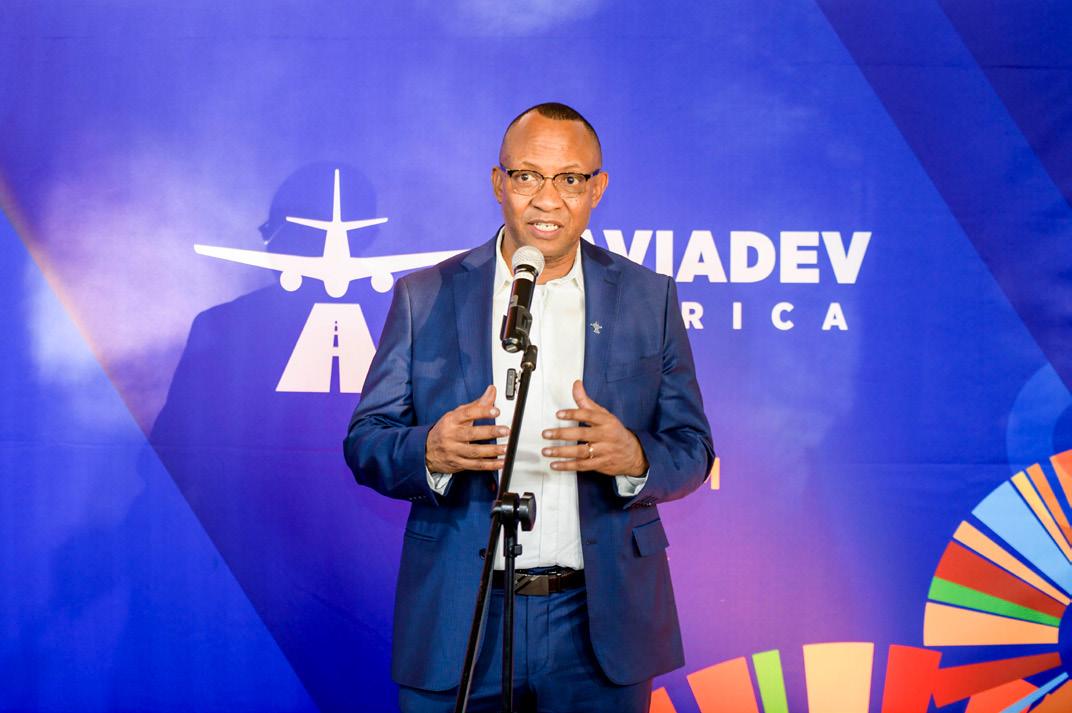

In a pioneering move for conservation and sustainable finance, Namibia has introduced its first Nature Positive certificate through a collaborative effort between Save the Rhino Trust Namibia (SRT) and the innovative technology firm Wadappt. This groundbreaking initiative utilises blockchain technology to verify conservation efforts, marking a significant advancement in the fight against wildlife crime and habitat destruction.
Launched in April 2024, the Rhino Guardianship Certificate ensures that funds raised directly contribute to rhino conservation efforts on the ground. The certification process, meticulously tracked and validated using the aforementioned blockchain technology, requires specific targets for kilometres patrolled and rhino sightings to be met by rhino rangers on the ground, ensuring that the certificates represent verified conservation achievements and helping prevent greenwashing.
The launch event, held in Windhoek, was attended by enthusiastic supporters, partners and key stakeholders from SRT, the Ministry of Environment, Forestry and Tourism, and corporate representatives who discussed the importance of these certificates in demonstrating tangible conservation impact to shareholders.
Each certificate supports Save the Rhino Trust’s rangers and contributes to Sustainable Development Goals (15, 8, 1), enhancing the local and global impact of each investment. Purchasers of the Rhino Guardianship Certificate buy a digital asset that represents real conservation work, with 90% of the purchase price directly funding the efforts on the ground.
These rangers, hailing from local communities, are at the forefront of protecting the world’s largest free-roaming population of black rhinos. Wadappt’s platform not only helps preserve these magnificent creatures but also fosters

economic growth without compromising the integrity of our natural resources, connecting global capital markets to real-world conservation projects.
This initiative represents a new paradigm in environmental financing. It goes beyond traditional funding methods like philanthropy or green bonds, offering a direct impact nature market that is a sustainable model which other conservation efforts around the globe could emulate.
For more information, or to contribute to this vital cause, interested parties are encouraged to visit wadappt.io or contact Save the Rhino Trust directly. This initiative stands as a beacon of hope, demonstrating that with the right tools and collaborative effort, we can ensure the survival of our planet’s most precious assets and foster a thriving, balanced relationship between humanity and nature.
Elzanne McCullochFirst published in the Winter 2024 issue of Travel Namibia magazine. Subscribe to Travel Namibia here: www.travelnewsnamibia.zinioapps.com/shop
How to Buy a Rhino Guardianship Certificate:
1. Visit the platform at wadappt.io
2. Browse through the available Rhino Guardianship Certificates and select one
3. Complete the purchase process online
4. Once purchased, the certificate is added to your digital asset wallet, providing proof of your contribution



Scientific name: Welwitschia mirabilis
Common name: Welwitschia
Namibia’s eponymous Namib Desert is thought to be the oldest desert in the world. It covers the entire coastline and also reaches into southern Angola and northern South Africa. Despite extreme temperatures and aridity, there is life in the Namib – sustained by night fogs which frequently roll in from the Atlantic. One of the survival artists of the plant kingdom is the Welwitschia mirabilis. In fact, it is dubbed a living fossil, because it probably is a relic from the Jurassic period some 145 million years ago. Carbon dating shows that the average lifespan of Welwitschias is 400 to 1500 years.
The Welwitschia is endemic to the Namib, and it is truly one of a kind. No plant anywhere on earth is remotely like it. It has some unique characteristics, most notably that it only grows two leaves throughout its life. They are never shed and just continue to grow. The typically tousled appearance of the plant is due to the leaves torn into ribbons over the years by external factors such as wind. The leaves are straplike, hard and leathery but some animals nevertheless chew on them. The woody stem is low and hollowed out. Its long tap root reaches underground water.
Welwitschias are gymnosperms, and the sexes are separate: there are male plants and female plants. The female cones are bigger and brighter, a greenish yellow with shades of red and brown in contours, while male cones are brownish-green. The cones flower from mid-summer to autumn and exude nectar with a high sugar content.
I remember learning about this plant in primary school. A delightful memory when I finally saw a Welwitschia at Gobabeb Research Station in my second year as an environmental science student on a class excursion. Like little soldiers we walked on the ridges crossing small valleys to see one of the biggest Welwitschia plants in close proximity. The desert heat got the best of us, but finally I was able to touch this iconic plant with its huge leaves like seaweed extended on the ground. The leaves were very hard and the stem felt like rock. The cones are not as tough to the touch as the leaves, but firmly in place so that they cannot be blown away by the wind.
On another visit to Gobabeb, in January 2021, we again went to see Welwitschia plants. Some were fenced off to prevent animals from chewing the leaves – and humans from interfering with the plants. We found plenty of cones on the plants.
A fun fact: our national rugby team is named after this iconic plant. I also learnt of two South African wines in honour of the Welwitschia plant. One of them had only 1560 bottles released.
The Welwitschia is named after Austrian botanist and explorer Friedrich Welwitsch. He came across his first specimen in 1859 in southern Angola. He recommended that the plant be named Tumboa, as it is known in Angola.
Agnes Shivute
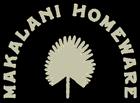









In the heart of Namibia’s vibrant school sport scene lies a story of empowerment and opportunity. Since 2018, Debmarine Namibia, in collaboration with the Namibia School Sport Union (NSSU), has embarked on a journey to nurture the athletic talents of the Namibian youth. What began as a vision to bolster school sport has blossomed into the enduring legacy of Bridging the Gap, a platform igniting passion and potential across Namibia.
In its inaugural year, Bridging the Gap set the stage for greatness, with Ongwediva hosting a spectacle that captured the essence of unity and camaraderie. From the dusty fields of rural schools to the courts of urban hubs, Bridging the Gap has transcended boundaries, reaching over 463 schools and 6,560 eager learners from every corner of Namibia. This year, Windhoek bore witness to the culmination of dedication and talent as over 300 schools and 770 learners converged for the regional finals, marking another milestone in the journey of Bridging the Gap.

At the heart of this initiative lies a commitment to more than just sport. It is about fostering connections, nurturing dreams, and paving pathways to success. Speaking during the handover ceremony, Willy Mertens, CEO of Debmarine Namibia, underscored the transformative power of sport as a catalyst for societal change. “Sport teaches us invaluable lessons,” he remarked. “It instils discipline, resilience and teamwork –qualities essential for our youth’s growth and development.”
Beyond the thrill of victory, Bridging the Gap is a beacon of hope, offering a lifeline to aspiring young athletes. Mertens emphasised the initiative’s broader impact, serving as a conduit for educational and career opportunities in marine diamond recovery – a testament to Debmarine Namibia’s commitment to holistic youth development.
Beyond the thrill of victory, Bridging the Gap is a beacon of hope, offering a lifeline to aspiring young athletes.
Following the successful edition of Bridging the Gap games last year, Debmarine Namibia held a handover ceremony to award the winners. These included the Kunene Region, which emerged victorious in soccer, while the Khomas Region walked away as winners in both athletics and netball. Winning schools received sport kits and equipment worth N$10,000. In addition, all players from the winning regions and officials were rewarded with N$1,500 worth of footwear. Runners-up were the ||Kharas, Otjozondjupa and Omaheke regions, where each school received sport kits worth N$5,000 and all players received N$750 worth of footwear. The total prize money for school equipment was N$720,000, while the prizes for individual learners amounted to N$190,000.
As Bridging the Gap enters a new chapter, the spirit of collaboration remains steadfast. Mertens affirmed Debmarine Namibia’s unwavering support, while entrusting the leadership of this initiative to the capable hands of NSSU and its affiliates. Together, they will chart the course for future endeavours, ensuring that Bridging the Gap continues to inspire and uplift generations to come.
Bridging the Gap is more than a sponsorship initiative; it is a promise to empower, uplift and ignite the flames of sport ambition in every Namibian child.

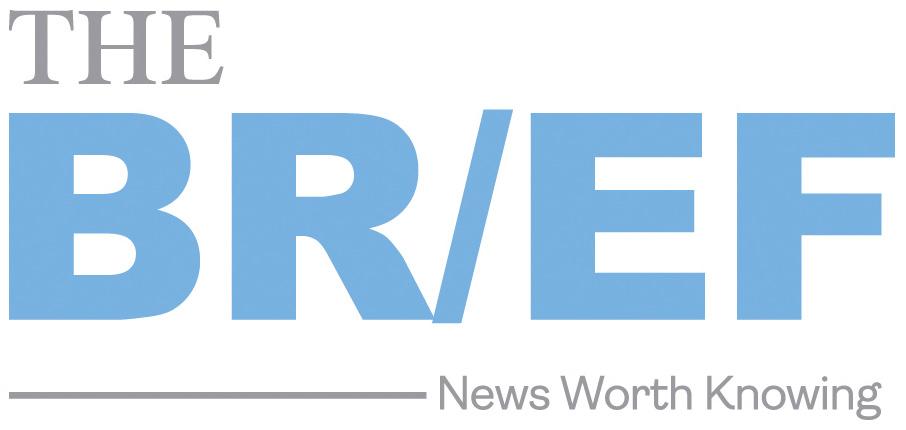

The Ministry of Health and Social Services (MoHSS) says it is still planning to implement universal health coverage (UHC), with the framework already approved by the Cabinet two years ago. According to MoHSS Minister, Kalumbi Shangula, the process is ongoing and involves extensive consultations with the public and various stakeholders. “Once these consultations conclude, a report will be compiled and reviewed before finalising the UHC implementation plan. The framework was approved by the Cabinet two years ago. We have set up structures, and consultation with the public, the government, and different stakeholders has been ongoing,” the Minister told The Brief.
He further explained that while there is no specific date for the UHC rollout, the current efforts aim to expand on primary health care and create a comprehensive UHC program. “It’s a process, so we don’t have a definite date of how long the process is going to take, but the most important element we are already implementing is primary health care,” he explained.
The UHC is expected to provide affordable health services to everyone in the country, as Namibia strives to reenvision the availability, accessibility, acceptability, and quality of health service delivery in a way that meets the needs and rights of all, especially key, marginalised, and vulnerable populations.

NAMRA PAYS N$10.4BN IN TAX REFUNDS, COLLECTS N$86.9BN
The Namibia Revenue Agency (NamRA) says it paid out N$10.4 billion in tax refunds at the end of the 2023-2024 financial year (FY23/24).
The national revenue collector collected N$86.9 billion in revenue, a 107.6% achievement from the N$71.1 billion target set for FY23/24. NamRA netted N$76.5 billion in revenue as of March 2024 after refunds.
The largest portion of tax revenue, according to NamRA Commissioner Sam Shivute, came from the international trade sector, contributing N$25.76 billion or 34% of the total, followed by individual income tax which contributed N$18.19 billion amounting to 24% and value-added tax (VAT) N$17.36 billion which is 23%. Corporate income tax contributed N$ 11 billion and 14% while CIT and other tax categories made up the remaining 14% amounting to 14,3 billion.
Toyota dominated Namibia’s vehicle sales in April 2024, with a 43.2% share of passenger vehicle sales and 50% of total sales, latest data reveals. According to data provided by Cirrus Capital’s Head of Data & Analytics, Tannan Groenewald, out of the 411 passenger units sold during the period under review, 174 were Toyota vehicles.

The Toyota Landcruiser PU and Hilux emerged as favourites among consumers, contributing to Toyota’s substantial presence in the industry.
Meanwhile, in passenger vehicles, Volkswagen trailed behind with a 14.1% market share, followed by Kia and Suzuki with shares of 11.7% and 9.0%, respectively.
Paratus Namibia Holdings Limited (Paratus) has successfully raised over N$600 million from its recent rights issue to expand its offerings by enhancing its core systems and infrastructure.
The raised capital, according to the telecommunications company, has been sourced from a diverse group of investors, including the Paratus Group (61.9%), institutional investors (34%), Paratus employees (2.6%), and retail investors (1.5%).
“Paratus Namibia Holdings Limited, in partnership with Cirrus Capital, a fully Namibian-owned financial services firm, has worked diligently to engage and inform both local and foreign shareholders regarding the Rights Issue, to ensure their comprehensive understanding and participation in the process. The successful investment secured from prominent institutional investors and additional investment from Paratus Group shareholders has contributed to the significant capital raised,” Paratus said.
The capital infusion, according to Paratus, has effectively doubled the company’s market capital on the Namibian Stock Exchange (NSX), and will be strategically allocated to expand Paratus Namibia’s existing offerings.

President Nangolo Mbumba has announced that Namibia and South Africa are set to collaborate on a groundbreaking initiative to develop Africa’s first-ever green hydrogen pipeline. He said this at the World Hydrogen Forum in the Netherlands. According to Mbumba, the partnership includes the Western Cape Development Agency (Wesgro) and the Northern Cape Economic Development, Trade and Investment Promotion Agency (NCEDA) from South Africa, along with Gasunie, a leading Dutch hydrogen infrastructure developer.
“This partnership aims to study the feasibility of building Africa’s first cross-country green hydrogen pipeline, connecting Namibia and South Africa and facilitating significant trade of a new product between our two countries,” he said.
Among some of the envisioned projects is the development of a 2,500-km cross-border pipeline from Lüderitz to Saldanha, a project which the Namibian Green Hydrogen Commissioner, James Mnyupe estimates will cost N$352.6 billion. Mbumba further explained that Namibia currently hosts nine hydrogen projects across two developing hydrogen valleys, with the potential for a third anchored by its iron ore.
He also revealed the country’s plans to become a logistics hub for the Southern African region through the development of an ammonia bunkering hub and a green hydrogen-powered train. These initiatives aim to decarbonise shipping and longhaul logistics routes, ensuring goods transported via Namibia’s ports minimise both scope 2 and scope 3 emissions.




We love seeing your journeys with FlyNamibia on Instagram. Keep Tagging!

@skycafe_eros
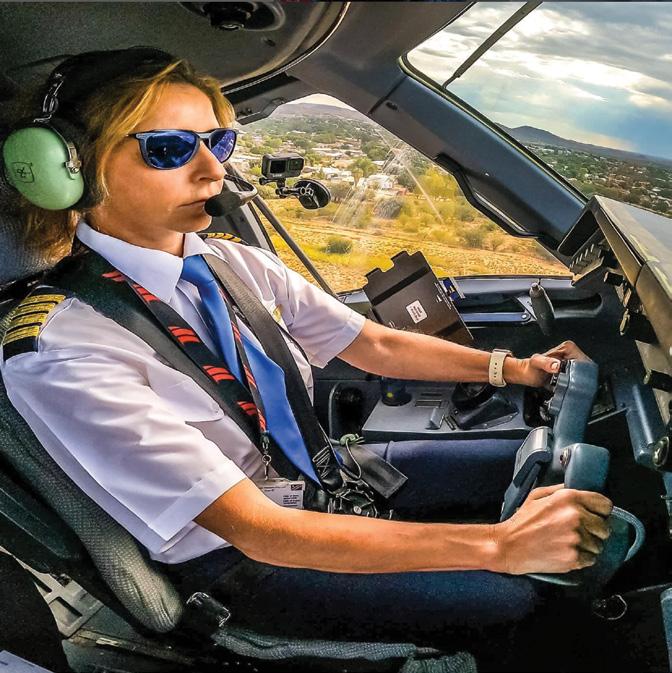

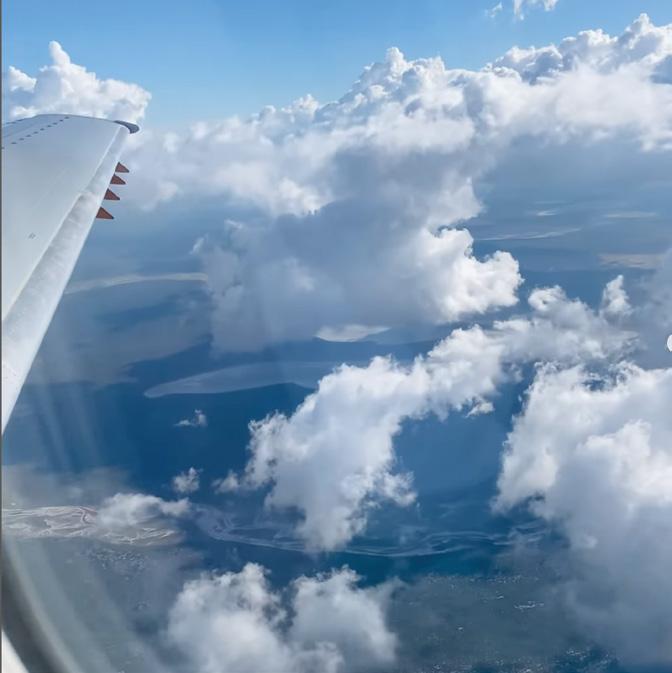
@hendry_ngondjodi @hilia_shinene



@justplanes_official @desillusion.ch

@uniquetoafrica


The adage “use it or lose it” holds particularly true for our brain’s functionality. Synapses, the connections between neurons, are vital for brain function, and if left unused, they can deteriorate over time. With the increasing reliance on technology, this phenomenon has become increasingly prevalent.
Synapses form as our brains encode new memories. Memory involves the acquisition, retention and retrieval of information. This system prioritises efficiency over accuracy and operates by recording moments. Approximately twenty minutes after reading this article, your brain initiates a coordinated burst of neuronal activity to store the newly acquired information as a memory.
Instead of meticulously cataloguing every life event, our brains store moments in time and reconstruct memories when needed. Neuroscientist Antonio Damasio, a Professor of Psychology, Philosophy and Neurology at the University of Southern California, describes memory as reconstructive. He notes that rather than exact recordings, our memories aim for approximations of past events. Unlike a photograph, our memory retrieval is not a simple replay of events but a complex process prone to errors due to its fragmented nature.
The fragmented nature of memory renders it susceptible to errors and distortions. Memories are not pristine replicas of past events but rather reconstructions influenced by various factors such as emotions, biases and external cues. This fragmentation occurs during encoding, storage and retrieval processes, leading to gaps, distortions and inaccuracies in memory recall. Additionally, memories can be altered over time through the process of memory consolidation, where new information integrates with existing memories, potentially distorting the original recollection. Consequently, our memories are often incomplete, selective and subject to change, highlighting the fallibility of human memory and the challenges of relying on it as an accurate record of past experiences.
Charan Ranganath, a neuroscientist and author of Why We Remember, suggests that human memory evolved to help us stay attentive to what is important. However, the common assumption that memory operates like a recording stored in the brain is flawed. Ranganath explains that this assumption overlooks two key factors: first, humans are not designed to remember everything; and second, memories are not exact replays of past events. Scientifically, people only retain a fraction of their experiences, and memories can be embellished, distorted or inferred, according to Ranganath.
THE ROLE OF TECHNOLOGY ON MEMORY FORMATION
Indeed, the act of learning new things stimulates neuronal activity in the brain, which is beneficial for brain health. However, the impact of technology on brain health is a
topic of ongoing debate. While it is commonly believed that smartphones have a negative effect on memory, the reality is more nuanced. On one hand, excessive smartphone use, especially when it leads to distraction and a lack of awareness of one’s surroundings, can impede the formation of memories. Conversely, smartphones also serve as repositories of vast knowledge, providing instant access to information from around the world. Therefore, the role of technology in brain health involves a complex interplay between potential distractions and the invaluable resource of readily available knowledge.
Digital dementia, a concept introduced by German neuroscientist and psychiatrist Manfred Spitzer in 2012, refers to cognitive changes resulting from excessive technology use. In an interview I conducted with him several years ago while he was in Namibia, Spitzer shared alarming anecdotes from his global work, where communities displayed early signs of dementia linked to prolonged screen time. He highlighted the pervasive nature of screen usage, emphasising how it bookends our daily routines, from the moment we wake up to the final moments before we fall asleep. Recent studies corroborate Spitzer’s concerns, with one indicating that as little as four hours of excessive screen use can detrimentally affect executive functioning and working memory.
Before we rush to blame technology for all memory concerns, it is essential to consider other factors contributing to cognitive health. Recent research indicates that a diet high in sugar and fat can lead to long-lasting memory issues, highlighting the importance of nutrition in cognitive function. Additionally, neurologists now caution against prolonged exposure to stress, which can also negatively impact memory.
Routine actions, due to their repetitive nature, are easily forgotten, such as whether one locked the front door. Conversely, engaging in new, challenging or unique activities stimulates neural activity, which is beneficial for brain health. Exercise as well as puzzles have a positive impact on memory.
The key takeaway is that it is crucial not to rely too heavily on retrieved memories, as they may not always be fully accurate. When we realise that memory is fallible, we realise that it has limitations and this helps us to approach information and experiences with a healthy scepticism. From this position we can critically evaluate the reliability of our recollections and the information we encounter. This awareness encourages us to seek multiple sources of information, verify facts and remain open to revising our understanding based on new evidence. Ultimately, recognising the fallibility of memory fosters a more accurate and nuanced understanding of the world around us.
Kirsty Watermeyer



In recent years, cricket in Namibia has undergone a remarkable transformation, marked by the unprecedented success of the national men’s team. Kirsty Watermeyer had the privilege of sitting down with Pierre De Bruyn, coach for Cricket Namibia, and Gerhard Erasmus, Captain of the national men’s team, to delve into the factors driving this upward trajectory and the dedication fueling the team's journey.
Success in cricket, as aptly described by Pierre De Bruyn, is unequivocally tied to winning games. The statistics speak volumes: a T20 international record boasting a 68% win rate and an ODI record with an impressive 57% winning percentage over the past five years. This string of victories has not only bolstered support within Namibia but has also garnered global respect, positioning the Namibian national men’s side as a force to watch on the international stage.
Behind the triumph lies sacrifice and unwavering dedication. Gerhard Erasmus sheds light on what happens off the pitch, from missed family gatherings to the toll of exhaustive travel schedules. The immense mental fortitude demanded of players as they navigate the pressures of performance and the relentless grind of elite competition cannot be understated. As Gerhard explains, “It’s expected that in any elite sport, you will be under pressure, and so it’s really about how you deal with that pressure.” This underscores that success in the sport is not solely reliant on physical prowess but also on the mental fitness required of a player. Pierre echoes these sentiments by explaining that the coaching staff place significant emphasis on maintaining the mental well-being of the players.
The journey to success extends far beyond the limelight of match days, as both coach and captain emphasise the rigorous training regimens and the meticulous attention to physical and mental conditioning. The behind-the-scenes efforts, from late-night training sessions to the strategic management of player workload, lay the groundwork for the team's stellar performances on the field.
An impressive spin-off of Cricket Namibia's success is the ability to now truly invest in players. Pierre explains that they now have full-time contracts with players. This means monthly salaries for professionals, which signifies that today there is a viable career path in cricket.
This wasn’t the case in the past. Pierre further explains that this extends to both men and women, as ten fulltime cricket contracts were recently awarded to Namibian women cricket players. Moreover, to grow the sport, Cricket Namibia has been proactive in promoting the sport at the grassroots level, enhancing the quality of cricket education, and expanding the player base across the country.
The future looks promising for Namibian cricket. With Namibia set to host significant ICC events in the coming years, the sport is expected to receive a substantial boost — infrastructure improvements, increased funding, and greater international exposure. According to Gerhard, “We’ve built this small legacy over the last five years, of which we can
be very proud. We've secured funding to build our own cricket stadium. It's so exciting for us as players to see. It is a defining moment for Cricket Namibia and the legacy of cricket in Namibia. We're going to have our own stadium hosting the Under 19 World Cup in 2026, and co-hosting a men's World Cup in 2027. And if you told someone that 10 years ago, they wouldn't have believed you.”
What’s more, regular participation in World Cups gives the players a platform to shine against the best in the world, enhancing their careers and the profile of Namibian cricket.
The 2024 ICC Men's T20 World Cup is set to ignite cricketing fervour across the globe, scheduled to be co-hosted by the West Indies and the United States from 1 to 29 June. Talking about the World Cup, Pierre notes that they “beat Sri Lanka in the previous World Cup, which was a huge upset in T20 cricket. So we’re hoping for another opportunity to rattle a few cages, and the first two games are going to be critical for us.”
When asked how the fans can support them at the World Cup this year, Gerhard, who is widely regarded as the most successful Captain this country has ever had, notes that they appreciate their fans dearly. “Everyone is quite close to our hearts in Namibia. It's a small community, and we've always felt that connection with the people. I remember the night we beat Sri Lanka, I was up so late on my phone because so many people sent me videos. Those things don't go unseen. They definitely are moments that inspire you to do more and be better.”
The success story of cricket in Namibia is not just about the trophies and accolades; it's about resilience, determination, and the unwavering pursuit of excellence. As the team continues to reach new heights, their journey stands as a testament to the transformative power of sport.
Listen to the full interview here:





Architecture has a long and intertwined history with chairs. This historic overlap was by no means established by, but arguably brought to the mainstream through the founding of Bauhaus – the German art school (operational from 1919 to 1933) that combined crafts and the fine arts. During this period, famous architects began designing chairs as a small-scale and practical outlet for their unique aesthetics. Some of the most fascinating furniture designs of the 20th century have sprouted from the minds of architects, who would undertake the challenge of scaling their usual, larger-than-life canvases to the humble chair.
Considered a rite of passage in the architecture world, designing a chair poses the challenge of turning the most rudimentary of furniture pieces into a thoughtful, ergonomic and aesthetic distillation of the architect’s ideals. Art historian Agata Toromanoff says architects turn to chairs because people can have a more intimate relationship with them than they can with one of their buildings. After all, what is a chair other than a dedicated building for your backside?
Take this quiz to find out which architectural chair best suits you, and would look fabulous in your home.
1. WHAT DO YOU CONSIDER THE MOST IMPORTANT ASPECT OF A CHAIR?
a. It must be comfortable to sit on
b. It should fit around/under a dining table
c. It should be aesthetically pleasing
d. It should be made with sustainable material
2. HOW WOULD YOU DESCRIBE YOUR DESIGN STYLE?
a. Minimalist and modern
b. Old-school and luxurious
c. Retro and unserious
d. Avant-garde and abstract
3. WHEN ENTERTAINING GUESTS, WHERE IN YOUR HOME WOULD YOU HOST THEM?
a. In the living room
b. Around the dining table
c. On the patio
d. Around the kitchen table
4. WHICH OF THE FOLLOWING STATEMENTS BEST DESCRIBE YOUR OUTLOOK ON ARCHITECTURE AND DESIGN?
a. Architecture and design should complement human nature, as an extension of ourselves and how we wish to experience our environments.
b. I’m not too concerned about architecture and design but enjoy simple aesthetics that don’t draw too much attention.
c. Comfort and ergonomics are the most important elements of architecture and design.
d. Sustainability, functionality and creativity should be at the forefront of new architecture and design. So many things already exist, it’s time to strip back to basics.
This iconic and timeless piece of furniture was designed in 1958 by Danish architect and designer Arne Jacobsen. The Egg Chair is celebrated for its unique and innovative design, characterised by its curved, cocoon-like shape that provides a sense of privacy and comfort. It was originally created for the lobby and reception areas of the Royal Hotel in Copenhagen. The chair’s sculptural form, combined with its swivel base, makes it not only visually striking but also functional and versatile. The Egg Chair has since become a design classic, sought after by collectors and enthusiasts alike, and it continues to be produced and admired to this day for its elegance and comfort.
Designed by Finnish-American architect and designer Eero Saarinen in 1957, the Tulip Armchair is a modern and innovative piece of furniture design, with nostalgic retro vibes. Saarinen’s aim was to create a chair that had a fluid and organic form, moving away from the traditional four-legged chair design. Originally designed as part of Saarinen’s Tulip collection, which also included dining tables and the Tulip chair without armrests with similar single-stem bases, the chair quickly gained popularity and is still considered an iconic symbol of modern design.
This striking creation by renowned architect Frank Gehry challenges conventional notions of furniture design with its dynamic and unconventional form. Crafted from corrugated cardboard, Gehry’s chair reflects his innovative approach to materials and construction techniques, showcasing the possibilities of bending and shaping humble materials into functional and visually captivating pieces. The chair’s undulating curves and playful appearance evoke a sense of movement and whimsy, making it a standout piece in modern furniture design. Gehry’s Wiggle Chair serves as a testament to his experimental spirit and artistic vision, pushing the boundaries of traditional design and inspiring creativity in the world of furniture.
Known for her groundbreaking and futuristic architectural designs, Hadid extended her innovative vision to furniture design with the Rise Chair. Characterised by its fluid and sculptural form, the Rise Chair embodies Hadid’s signature style of organic and dynamic shapes. The chair’s sinuous curves and seamless lines create a sense of movement and elegance, blurring the lines between art and function. Crafted utilising advanced 3D printing, the Rise Chair is not only visually striking but also innovative. It represents Hadid’s commitment to pushing the boundaries of design and creating objects that challenge conventions while remaining functional and accessible.
Charene LabuschagneQuiz scoring : 1. a-1, b-2, c-3, d-4. 2. a-3, b-1, c-2, d-4. 3. a-1, b-3, c-4, d-2. 4. a-4, b-2, c-1, d-3.




to host the
As the Africa Hospitality Investment Forum (AHIF) gears up to grace the vibrant city of Windhoek this month, the spotlight once again falls on Namibia’s burgeoning potential as an investment destination.
Nangula Uaandja, the chairperson and chief executive director for the Namibia Investment Promotion and Development Board (NIPDB) spoke to us to explain the allure of Namibia for investors and the pathways towards fully realising its investment potential.
“Namibia is one of the most lucrative investment destinations in Africa, offering investors unique opportunities, particularly as the government has made a deliberate commitment to diversify the country’s economy beyond traditional sectors such as mining and agriculture. The growth of industries such as tourism, manufacturing, renewable energy and global business services has created new investment opportunities with untapped potential for growth and longterm profitability.”
When talking about the attractiveness of investment in Namibia, Uaandja notes, “Namibia offers an investorcentric business environment that is well structured with predictable policies and regulations. Add to that an abundance of natural resources, a young and trainable workforce and a strategic location with direct access to the African market of over 300 million people through our world-class ports.” She adds, “Namibia also has a wellmaintained infrastructure, including the best roads in Africa, developed communication and internet infrastructure, as well as strong legal and regulatory systems.”
The NIPDB serves as the first point of call for potential investors wanting to do business in Namibia and is committed to making Namibia the investment destination of choice by improving the ease of doing business here, starting with eliminating red tape and driving policy reforms. Uaandja explains, “From an investment attraction perspective, the government remains committed to collaborating with relevant public and private sector stakeholders to ensure Namibia sustains a conducive investment environment, underpinned by progressive policy frameworks and predictable structures and processes.”
Exciting to note is that investor confidence in Namibia is at an all-time high according to the NIPDB. This is evidenced by various rankings such as fDi Intelligence’s annual FDI Standouts Watchlist which ranked Namibia as fifth in the world in foreign direct investment (FDI) momentum.
Additionally, in 2022, Namibia secured the top position in Africa and 13th globally in the Greenfield FDI Performance Index, which assesses the FDI that countries have attracted in proportion to the size of their economy.
When talking about the future and whether we have fully unlocked the investment potential here, Uaandja says, “Namibia’s investment potential is as dynamic and vast as her landscapes, and we have only just scraped the surface. With opportunities spanning across various sectors such as tourism, agriculture, mining and renewable energy, among others, Namibia’s investment potential is yet to be fully unlocked, and therein lies the opportunity for investors seeking to do business in a politically stable and progressive environment.”
Speaking about how to achieve this, Uaandja – a seasoned businesswoman and chartered accountant by trade –shares that there are various ways that the investment potential of Namibia can be further unlocked. This includes increased infrastructure investment. “More investment into infrastructure projects such as roads, ports, railways and energy infrastructure will enable Namibia to leverage on trade and economic regional blocks such as SADC, SACU, AfCFTA and others. This will increase market access, facilitate trade and attract investment through regional cooperation initiatives.”
As Namibia’s Investment Promotion Agency, the NIPDB exists to unlock opportunities that enable a better quality of life for all Namibians, and attracting investments by foreign and local investors is the strongest lever the country can pull to realise this goal. In this regard, the NIPDB activities are aligned with the government’s economic developmental agenda, which includes diversification of the economy. “By diversifying our economy, we will reduce vulnerability to commodity price fluctuations and create new opportunities for investment.”
With a strategic focus on infrastructure development, economic diversification and fostering a conducive investment climate, Namibia is poised to emerge as a shining beacon of opportunity in Africa’s investment landscape.
If you would like to hear more about the potential for investment that Namibia holds in hospitality, and the areas that will help unlock these opportunities, be sure to join the Africa Hospitality Investment Forum.
Kirsty Watermeyer

In the verdant expanses of the Nkulivere landscape in the Kavango West Region of Namibia, a transformative initiative, managed by the Namibia Nature Foundation under NILALEG, is taking root. The NILALEG project is at the forefront of pioneering development, aiming to uplift local communities through sustainable natural resource management by integrating environmental stewardship with economic growth. I recently had the opportunity to discuss this initiative with Werner Mbongo, the project coordinator for NILALEG’s Nkulivere landscape, as we sat on the banks of the Okavango River just outside Nkurenkuru.
At the heart of NILALEG’s mission in Nkulivere is the integration of community-based projects that not only support but also enhance local livelihoods. Werner detailed several initiatives that are tailored to the unique needs and potentials of the region. Among these is a dynamic Woodcarvers’ Cooperative, which benefits from a newly constructed carpentry workshop located next to the Mpungu Constituency and Regional Directorate of Forestry offices. This cooperative, composed of an organised group of community members, facilitates local craftsmanship, while its collaborative efforts with the constituency and Directorate of Forestry ensure sustainable wood-harvesting practices that are respectful of the region’s rich forest resources. The establishment of the Mutjimangumwe Carpentry Workshop is a testament to this initiative’s success, providing a dedicated space for woodcarvers to hone their skills and produce valuable products like furniture which can be sold to communities, schools, hospitals and more, which in turn boosts local income.
Agricultural support is another cornerstone of NILALEG’s efforts. The project has introduced an innovative approach to livestock farming with a revolving small-stock programme. This initiative provides local farmers with goats, which they grow and then pass on some of their herd to other farmers in the community, creating a sustainable cycle of wealth and resource sharing. This method not only enhances livestock production but also strengthens community bonds and resilience.
Moreover, Werner highlighted innovative support structures to agriculture that involve the construction of boreholes and earth dams. Through this additional infrastructure, NILALEG is addressing the perennial challenge of water scarcity in Nkulivere. These projects enable the development of community gardens that provide food and a source of income, with the added benefit of using irrigation to reduce dependency on unpredictable rainfall, ensuring that agricultural practices are not solely reliant on erratic rainfall but are supported by sustainable water management techniques.
In addition to these agricultural endeavours, NILALEG supports the harvesting of local natural products like mangetti nuts and devil’s claw, both of which offer significant economic potential. The devil’s claw project, in particular, is a stellar example of sustainable resource use, where harvesters are trained to collect parts of the plant in a way that ensures its continued growth and availability.
Crucial to the success and longevity of these initiatives is NILALEG’s focus on establishing multi-stakeholder engagement structures. These collaborative platforms bring together a variety of stakeholders, including government and non-governmental organisations, to ensure that the projects continue to benefit the community long after the initial phase of NILALEG concludes. This structure not only leverages existing expertise and infrastructure within government and non-government institutions, but also fosters a sense of ownership and responsibility among local participants.
Werner also shared insights into the challenges faced, such as aligning the diverse perspectives of various stakeholders, including regional councils and traditional authorities. However, he remains optimistic about overcoming these obstacles through continued dialogue and collaboration, reinforcing the community’s capacity to manage and expand on the work initiated by NILALEG.
As NILALEG approaches its planned conclusion in 2025, the focus remains on ensuring these projects are sustainable and self-sustaining. The short- to medium-term plans include continued support for existing projects like the carpentry workshop, as well as expanded training and resource management plans to enhance the output and benefits of projects like the mangetti nut processing and devil’s claw harvesting. Furthermore, a collaborative effort toward establishing a regional forestry reserve is also in the works.
Our conversation with Werner, under the shade of a leadwood tree, was a firsthand look at the tangible impacts of thoughtful, sustainable development efforts. In Nkulivere, through the diligent work of the NILALEG project and its many partners, the threads of tradition, community and sustainability are woven into a basket, which holds the key to improved livelihoods and environmental stewardship. As this project continues to unfold, it stands as a compelling model of how integrated, community-focused conservation efforts can make a significant difference in the lives of many.
For more visit: www.meft.gov.na/projects/nilaleg-project
Elzanne McCulloch


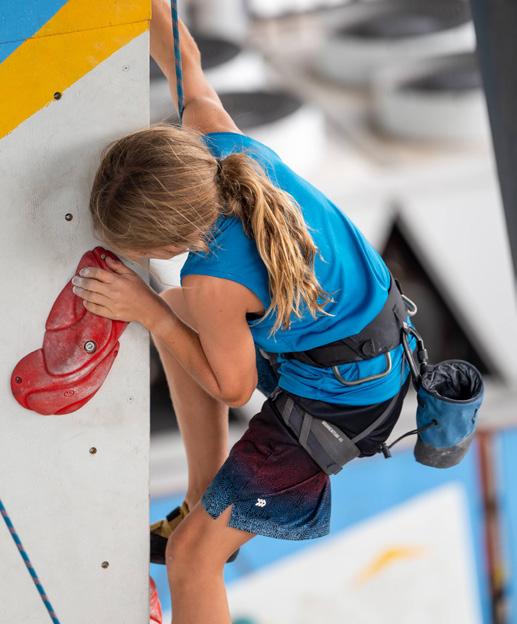



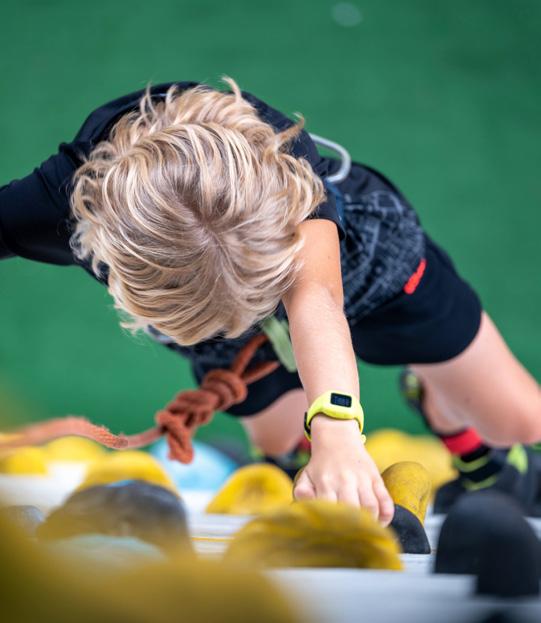





Coronation of Queen Elizabeth II of the United Kingdom in Westminster Abbey. Celebrating 70 years in 2022, she was the longest-reigning monarch in British History.
The US Center for Disease Control and Prevention reported the first cases of the disease later known as AIDS.
Captain James Cook, commander of the British ship Endeavor discovered the Great Barrier Reef by running onto it. After extensive repairs to the ship, it took the crew three months to navigate the mazelike construction of the reef.

The Statue of Liberty arrives in New York City. The 46 meters high, 225-ton statue was a gift from France to commemorate their friendship with the United States.
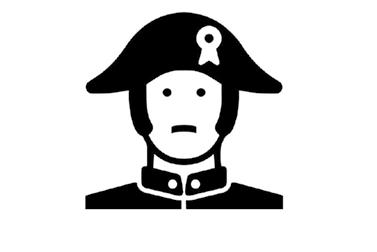
Napoleon Bonaparte was defeated at the Battle of Waterloo, after which he was exiled to St Helena.

Prince released his album "Purple Rain" which spent 24 consecutive weeks at number one on the Billboard 200.

The first ever Grand Prix was raced at Le Mans in France. Ferenc Szisz won the 1,238.16 km race in a Renault.

Isabel Peron became president of Argentina, making her the first female president in history.

The birthstone of June is moonstone and pearl.

Those born in June have the birth flower honeysuckle or rose. Both flowers are symbols of all things relating to love, desire, generosity, and affection.
The goal of Sudoku is to fill a 9×9 grid with numbers so that each row, column and 3×3 section contain all of the digits between 1 and 9.
observe and take part!




Black with white stripes? Who would have thought! | At first glance, it may seem zebras are white with black stripes, however, appearances are deceiving. Zebra fur, both black and white, grows from follicles with melanocyte cells, which produce melanin, the pigment for skin and hair color. Chemical messengers determine where melanin appears, creating the zebra's pattern. The white fur is simply an absence of melanin, making black the default color. Underneath their fur, zebras have black skin; without stripes, a shaved zebra would be almost unrecognisable as an all-black animal.






